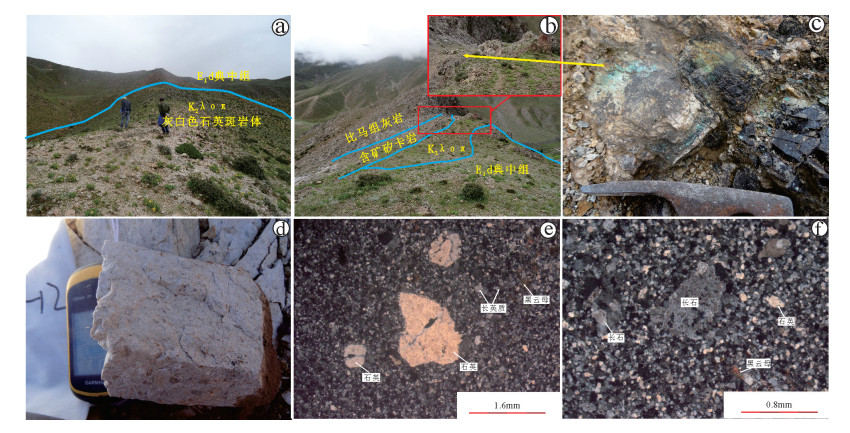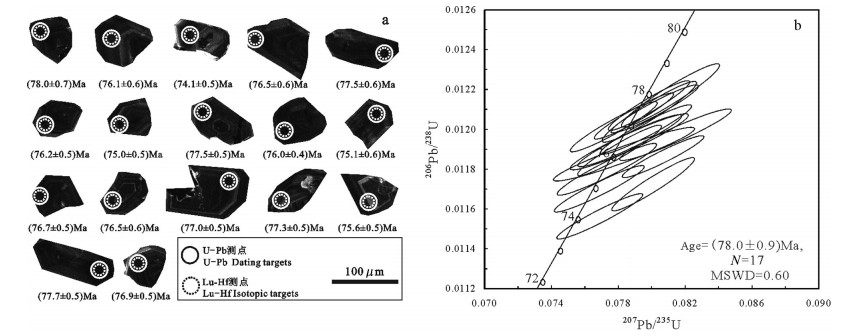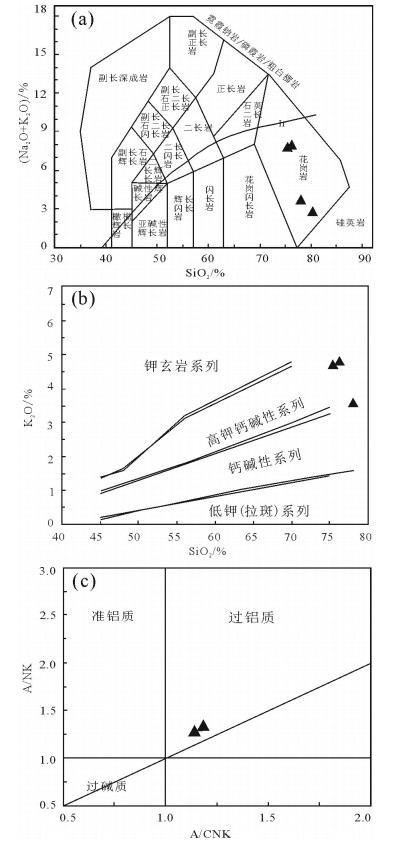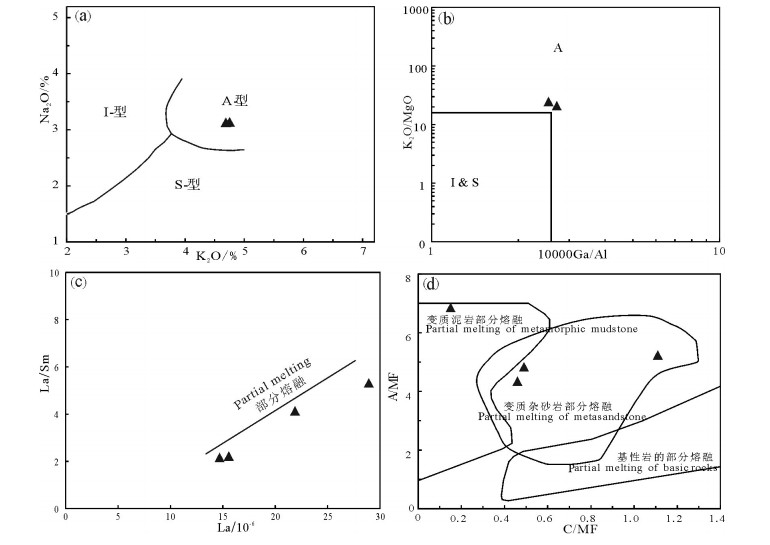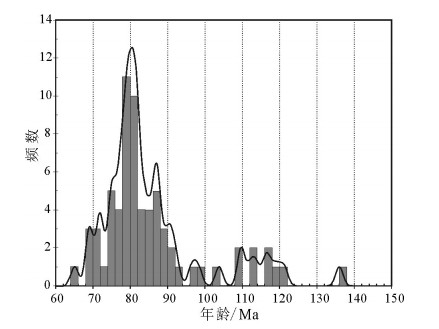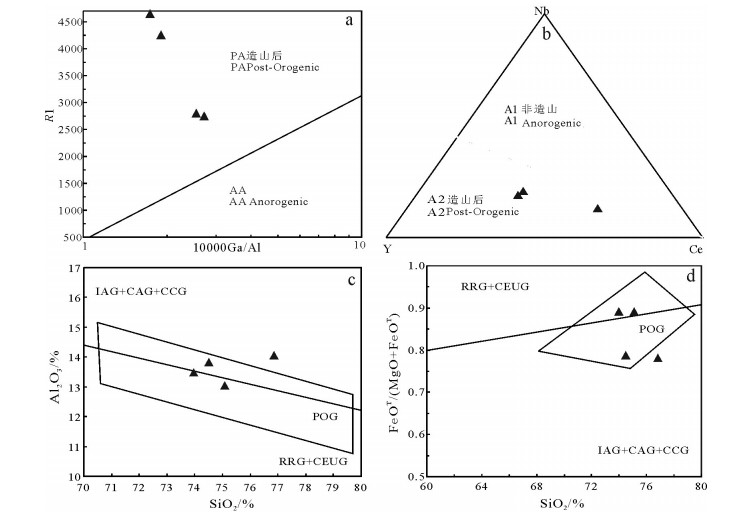Recongnition of A-type granite and its implication for magmatism and mineralization in Tangge skarn-type Cu-polymetallic deposit, Tibet
-
摘要:研究目的
唐格矽卡岩型铜多金属矿区位于南冈底斯陆缘火山-岩浆弧西段,矿区内铜多金属成矿与石英斑岩体成岩作用关系密切,但对矿区内发育的石英斑岩体研究较少,对于进一步理解矿床成因与指导找矿勘查有一定制约。
研究方法本文首次报道了矿区内石英斑岩岩石地球化学、锆石U-Pb年龄及Hf同位素结果。
研究结果石英斑岩表现出富硅(SiO2=73.97%~76.85%)、富铝(Al2O3=13.03%~14.06%)、高钾(K2O=2.2%~4.68%),高FeOT(0.97%~1.80%)、FeOT/MgO(3.57~8.22)、A/CNK(1.14~4.24)特征; 稀土元素总量高(∑REE=478.59×10-6~532.71×10-6)、稀土配分曲线呈明显的右倾型或“海鸥型”; 富集Rb、Th、U、K、Pb大离子亲石元素(LILE),亏损高场强元素(HFSE)Nb、Ta、Ti、P及大离子亲石元素Ba、Sr等元素; Rb含量低(69.64×10-6~249×10-6,小于270×10-6),10000Ga/Al=2.54~2.71,显示出后碰撞铝质A型花岗岩的地球化学特征。LA-ICP-MS锆石U-Pb年龄为(78.0±0.9)Ma,表明其形成时代为晚白垩世。石英斑岩中锆石的εHf(t)均为正值(1.5~5.3,均值3.6),显示了较均一的Hf同位素组成; Hf同位素二阶段模式年龄T2DM=1052~806 Ma,均值912 Ma(<1.0 Ga),指示岩浆主要来源于新生长英质下地壳的部分熔融。
结论结合区域地质资料,认为唐格铝质A型花岗岩是形成于印度大陆向北俯冲于欧亚大陆引起的碰撞后伸展构造环境。唐格石英斑岩中Cu、Pb、Zn、Au背景含量较高,说明铝质A型花岗岩为唐格矽卡岩型铜多金属矿提供了一定的成矿物质。冈底斯带自东向西在69~89 Ma至少存在一次与晚白垩世岩浆作用有关的铜多金属成矿作用,其唐格矽卡岩型铜多金属矿是冈底斯带中段南部在燕山晚期造山后岩浆活动的成矿响应。
创新点: 唐格矿区晚白垩世铝质A型花岗岩的发现不仅能够极大地促进唐格矽卡岩型铜多金属矿的勘查找矿,而且还推动了朱诺整装勘查区及周边扩大找矿方向和新的找矿思路。
Abstract:This paper is the result of mineral exploration engineering.
ObjectiveThe mineralization of Tangge skarn-type Cu-polymetallic ore district, located in the western part of the Gangdese volcano-magmatic arc, is closely related to the diagenesis of quartz porphyry in the mining area. There is little research on the quartz porphyry developed in the mining area, which restricts the further understanding of the genesis of the deposit and the guidance of prospecting and exploration.
MethodsWe firstly reports zircon U-Pb age and Hf isotope, and petrogeochemistry of quartz porphyry in the Tangge ore district.
ResultsThe quartz porphyry is characterized by high silicon (SiO2=73.97%-76.85%), aluminum (Al2O3=13.03%-14.06%), potassium (K2O=2.2%-4.68%), FeOT(0.97%-1.80%) contents, and high FeOT/MgO ratios (3.57-8.22) and A/CNK= values(1.14-4.24). The quartz porphyry have high REE (∑REE=478.59×10-6-532.71×10-6) and its chondrite-normalized REE distribution patterns diagram show obvious right-leaning or "gull" type. They are enriched in Rb, Th, U, K and Pb, depleted in Nb, Ta, Ti, P, Ba and Sr. The low contents of Rb (69.64×10-6-249.00×10-6, less than 270×10-6) and high 10000×Ga/Al ratios (2.54-2.71), indicate that the quartz poyphyry are post-collisional and aluminous A-type granite. LA-ICP-MS zircon dating for quartz porphyry yields a weighted mean age of (78.0±0.9) Ma, suggesting that they formed in the Late Cretaceous. Their zircons have positive εHf(t) values (+1.5–+5.3, averages of +3.6), showing a relatively homogeneous Hf isotopic composition. Two-stage Hf model ages (T2DM=1052-806 Ma, averages of 912 Ma, less than 1.0 Ga), indicate that they were mainly generated by partial melting of the juvenile felsic lower crust.
ConclusionsCombined with previous research, we proposed that the Tangge quartz porphyry were formed in the post-collisional extensional tectonic environment, which was resulted from the northward subduction of the Indian contient to the Eurasian continent. Tangge quartz porphyry has relatively high background content of Cu, Pb, Zn and Au, which suggest that genetical relationship between the aluminous A-type granitic magmatism and Tangge skarn-type Cu mineralization. It is inferred that Gangdese Belt at least develops a period of Cu polymetallic mineralization related to Late Cretaceous magmatism during 69-89 Ma, however, Tangge skarn-type Cu polymetallic deposits response to magmatism in the middle segment of the Southern Gangdese Belt during late Yanshanian.
-
Keywords:
- Copper polymetallic deposit /
- skarn /
- aluminous A-type granite /
- zircon U–Pb age /
- geochemistry /
- Hf isotope /
- mineral exploration engineering /
- Tangge /
- Tibet
-
1. 引言
冈底斯带位于青藏高原的西南部(图 1a,b),具有得天独厚的岩浆作用及其成矿作用,在青藏高原碰撞造山与成矿作用研究方面取得了重大成果进展引人瞩目(侯增谦等,2003; Hou et al., 2009; 秦克章等,2014; Huang et al., 2020; Tang et al., 2021; 赵亚云等,2021; Yang et al., 2022)。近年来,前人在冈底斯带白垩纪岩浆作用(和钟铧等,2006; Wen et al., 2008; 何利等,2009; Ji et al., 2009; 管琪等,2010; Zhang et al., 2010; 江军华等,2011; 刘建兵等,2012; 曲晓明等,2012; 丁鹏飞等,2014; 关俊雷等,2014; 谢龙等,2015; 张乐,2015; Zhu et al., 2017; 秦松等,2018; 邱婵媛等,2018; 张泽明等,2019)和矿床成因研究方面取得了丰硕的研究成果(赵元艺等,2011; 高顺宝等,2011; 余红霞等,2011; 定立等,2012; 王江朋等,2012; 姚晓峰等, 2012, 2013; 李小赛等,2013; 王力圆等,2014; 于玉帅等,2015; 张乐,2015; 田坎等,2019),如冈底斯岩浆岩带的岩浆作用是幕式的,具有3个明显的强烈爆发峰期及爆发期后的次级小高峰,前者分别为晚白垩世(95~90 Ma)、早始新世(52~48 Ma)和早—中中新世(18~14 Ma),后者分别为晚白垩世(70~65 Ma、78~73 Ma)、渐新世(30~23 Ma)和晚中新世(10~8 Ma); 冈底斯带内岩浆作用与其斑岩-矽卡岩型铜多金属成矿作用密切,其冈底斯成矿带又位于南冈底斯岩基之中,是中国重要的铜矿资源富集区,已探明的驱龙、甲玛、厅宫、雄村、朱诺、尕尔穷、帮布勒、尼雄等超大型—大型斑岩铜多金属矿床,铜矿资源量超过3000万t。以上成果为认识和理解冈底斯带白垩纪岩浆作用时空格架和成矿作用提供了丰富的资料。
![]() IYZSZ—印度河—雅鲁藏布江缝合带; SMLMF—沙莫勒—麦拉—洛巴堆—米拉山断裂; GLZCF—噶尔—隆格尔—扎日南木错—错麦断裂带; DMDF—达瓦错—马尔下—德庆断裂; SLYNJOMZ—狮泉河—拉果错—永珠—嘉黎蛇绿混杂岩带; BNSZ—班公湖—怒江缝合带; JSSZ—金沙江缝合带; N.Gandese—北冈底斯带(或北部拉萨地块); M.Gandese—中冈底斯带(或中部拉萨地块); S.Gandese—南冈底斯带(或南部拉萨地块); 1—第四系; 2—典中组一段; 3—比马组三段; 4—比马组二段; 5—比马组一段; 6—麻木下组; 7—闪长玢岩; 8—石英斑岩; 9—花岗闪长岩; 10—正断层; 11—逆断层; 12—地质界线; 13—角度不整合; 14—矽卡岩型矿体; 15—矽卡岩; 16—采样位置及编号; 17—矿产地; 18—同位素年龄; 19—本次同位素年龄Figure 1. The geotectonic location of the study area (a) (after Zhao Yayun et al., 2019), distribution map of temporal and spatial framework of Cretaceous granites in Gangdese belt (b) (after Zhu Dicheng et al., 2006), and geological map of Tangge in Angren County, Tibet (c)IYZSZ-Indus River-Yarlung-Tsangpo Suture Zone; SMLMF-Shamole-Maila-Luobadui-Milashan Fault; GLZCF-Geer-Longgeer-Zharinanmucuo-Cuomai Fault; DMDF-Dawacuo-Maerxia-Deqing Fault; SLYNJOMZ-Shiquan River-Laguocuo-Yongzhu-Jiali Ophiolitic Mélange Zone; BNSZ-Bangonghu-Nujiang Suture Zone; JSSZ-Jinshajiang Suture Zone; N.Gandese-Northern Gangdese (or Northern Lhasa subterrane); M.Gandese-Middle Gangdese (or Middle Lhasa subterrane); S.Gandese-Southern Gangdese (or Southern Lhasa subterrane); 1-Quaternary; 2-First Member of the Dianzhong Formation; 3-Third Member of the Bima Formation; 4-Second Member of the Bima Formation; 5-First Member of the Bima Formation; 6-Mamuxia Formation; 7-Diorite porphyrite; 8-Quartz porphyry; 9-Granodiorite; 10-Normal fault; 11-Reverse fault; 12-Geological boundary; 13-Angular unconformity; 14-Ore body of skarn- type; 15-Skarn; 16-Sampling location and number; 17-Ore field; 18-Isotopic age; 19-Isotopic age of this study
IYZSZ—印度河—雅鲁藏布江缝合带; SMLMF—沙莫勒—麦拉—洛巴堆—米拉山断裂; GLZCF—噶尔—隆格尔—扎日南木错—错麦断裂带; DMDF—达瓦错—马尔下—德庆断裂; SLYNJOMZ—狮泉河—拉果错—永珠—嘉黎蛇绿混杂岩带; BNSZ—班公湖—怒江缝合带; JSSZ—金沙江缝合带; N.Gandese—北冈底斯带(或北部拉萨地块); M.Gandese—中冈底斯带(或中部拉萨地块); S.Gandese—南冈底斯带(或南部拉萨地块); 1—第四系; 2—典中组一段; 3—比马组三段; 4—比马组二段; 5—比马组一段; 6—麻木下组; 7—闪长玢岩; 8—石英斑岩; 9—花岗闪长岩; 10—正断层; 11—逆断层; 12—地质界线; 13—角度不整合; 14—矽卡岩型矿体; 15—矽卡岩; 16—采样位置及编号; 17—矿产地; 18—同位素年龄; 19—本次同位素年龄Figure 1. The geotectonic location of the study area (a) (after Zhao Yayun et al., 2019), distribution map of temporal and spatial framework of Cretaceous granites in Gangdese belt (b) (after Zhu Dicheng et al., 2006), and geological map of Tangge in Angren County, Tibet (c)IYZSZ-Indus River-Yarlung-Tsangpo Suture Zone; SMLMF-Shamole-Maila-Luobadui-Milashan Fault; GLZCF-Geer-Longgeer-Zharinanmucuo-Cuomai Fault; DMDF-Dawacuo-Maerxia-Deqing Fault; SLYNJOMZ-Shiquan River-Laguocuo-Yongzhu-Jiali Ophiolitic Mélange Zone; BNSZ-Bangonghu-Nujiang Suture Zone; JSSZ-Jinshajiang Suture Zone; N.Gandese-Northern Gangdese (or Northern Lhasa subterrane); M.Gandese-Middle Gangdese (or Middle Lhasa subterrane); S.Gandese-Southern Gangdese (or Southern Lhasa subterrane); 1-Quaternary; 2-First Member of the Dianzhong Formation; 3-Third Member of the Bima Formation; 4-Second Member of the Bima Formation; 5-First Member of the Bima Formation; 6-Mamuxia Formation; 7-Diorite porphyrite; 8-Quartz porphyry; 9-Granodiorite; 10-Normal fault; 11-Reverse fault; 12-Geological boundary; 13-Angular unconformity; 14-Ore body of skarn- type; 15-Skarn; 16-Sampling location and number; 17-Ore field; 18-Isotopic age; 19-Isotopic age of this study唐格矽卡岩型铜多金属矿床位于西藏昂仁县亚木乡萨拉达村北,为西藏自治区地质矿产勘查开发局第二地质大队在开展的“西藏昂仁—谢通门朱诺铜矿整装勘查区矿产调查与找矿预测”时发现的一处具有巨大铜成矿潜力的矿床,其Cu+Pb+Zn资源量9.96万t,伴生银200.28 t(在MRAS2.0操作平台下,对其资源量进行最小找矿靶区预测,其预测结果为铜资源量44.78万t),成为了近年来取得重大找矿突破的斑岩型-矽卡岩型铜-钼多金属成矿带的重要组成部分。矿区内岩浆侵入活动强烈,出露的岩石主要有石英斑岩、花岗闪长岩和闪长玢岩(图 1c)。对于唐格铜多金属矿床,前人不仅开展了详细的调查和找矿勘查工作❶,而且还进行了详细的矿床地质特征和流体包裹体研究(申亚辉,2016),结果表明铜多金属矿化与石英斑岩体的关系密切,成矿与深部岩浆流体密切相关。虽然前人已取得初步研究成果,但是对于区内发育的岩浆岩研究较少,这对进一步理解矿床成因和找矿勘查有一定制约作用。
本文选取与矿化有关的石英斑岩为研究对象,开展详细的野外地质学、岩相学、地球化学和锆石U-Pb年代学与Lu-Hf同位素研究,总结其野外地质和岩相学特征,厘定其成岩时代,探讨岩石成因,试图对晚白垩世岩浆演化与成矿提供新的制约。
2. 地质概况
唐格矿区位于南冈底斯陆缘火山-岩浆弧西段(潘桂棠等,2006; 赵亚云等,2017),矿区出露地层主要为侏罗系—下白垩统桑日群(麻木下组和比马组)和古近系典中组两套火山-沉积岩石组合及第四系(图 1c)。麻木下组(J3-K1m)岩石类型为粉砂岩、泥晶灰岩、生物碎屑灰岩,与上覆地层比马组呈整合接触。比马组(K1b)以中酸性火山喷发岩与沉积岩为主,可以分为3个段: 一岩段为土灰色厚层状凝灰质砂岩; 二岩段岩石类型有灰色条带状灰岩夹透镜状矽卡岩、褐色碎裂状矽卡岩、孔雀石化石英脉; 三岩段为深灰色厚层状砂岩。典中组(E1d)为一套安山质晶屑凝灰岩,与下伏比马组呈角度不整合接触。构造发育,为北东向和近南北向的断裂构造。断层处见破碎带,破碎带蚀变极强,地表所见蚀变类型主要有褐铁矿化、钾化、黄铁绢英岩化、青磐岩化、硅化等。破碎带裂隙充填石英、硫化物、绢云母、绿泥石、方解石等细脉。矿区内火山及岩浆活动强烈,火山岩主要以林子宗群典中组火山地层的形式产出于区内的西部,侵入岩主要为石英斑岩、花岗闪长岩、黑云花岗闪长岩及脉状产出的闪长玢岩脉,其中石英斑岩体与矽卡岩成矿密切相关。
矿区目前发现4条矽卡岩带,圈定4个铜多金属矿(化)体(图 1c),均产于比马组二段矽卡岩及矽卡岩化灰岩中,呈层状或似层状产出。矿化主要发育在大理岩、凝灰岩、火山角砾岩及其中的矽卡岩。矿石矿物主要为闪锌矿、黄铁矿、磁黄铁矿、含方铅矿和黄铜矿。脉石矿物主要为石榴石、透辉石、绿帘石、绿泥石、硅灰石、石英、方解石等。蚀变主要有石榴子石化、辉石化、硅灰石化、绿帘石化、绿泥石化、硅化以及碳酸盐化。Ⅱ号铜矿化矽卡岩带为主矿带,产状4°∠65°~78°,长1600 m,宽20~180 m。其中Ⅱ-1铜多金属主矿体。控制长390~487 m,厚度1.4~30.5 m(平均厚度8.0 m),控制斜深155 m,平均品位: Cu 1.40%、Pb 1.03%、Zn 2.34%、Ag 116.19 g/t,估算Cu+Pb+Zn资源量约9.96万t,伴生银约200.28 t。
3. 样品采集和岩相学
矿区内发育5个石英斑岩体,大小不等(<0.2 km2),呈岩株状产出与围岩呈侵入接触(图 2a)。本次研究共采集5块样品,采样位置见图 1c,地理坐标: 17D-1和17DGS-1(29°39'11" N, 87°38'45" E)、17DGS-11(29°39'10" N, 87°38'44" E)、17DGS-12(29°39'20" N, 87°38'09" E)、D0845/8-1(29°39'19" N, 87°38'14" E)。石英斑岩主要为斑状结构,斑晶主要以石英、长石为主(图 2b),约占20%。石英呈他形粒状,粒径为1~2 mm,具波状消光,见边缘被溶蚀呈圆状或港湾状(图 2c,d); 长石主要以斜长石为主,呈柱状,粒径为0.5~2 mm,表面见黏土化、绢云母化,较浑浊(图 2d)。基质约占80%,呈显微嵌晶状,粒径多在0.02~0.2 mm,成分见主要为长石、石英,发育弱重结晶作用,颗粒多见略呈浑圆状,部分见围绕、交代斑晶矿物(图 2d)。其中,长石见斜长石、碱性长石均可见,发育黏土化、绢云母化。另见少量细小鳞片状黑云母,发育弱的绿泥石化。
![]() 图 2 唐格石英斑岩野外露头、岩石手标本及显微镜下特征a—石英斑岩露头; b—矽卡岩带及接触关系露头; c—含矿矽卡岩; d—石英斑岩手标本; e, f—斑状结构Figure 2. Photographs showing field and hand specimen characteristics for the Tangge quartz porphyrya-Outcrops of quartz porphyry; b-Sharn belt and contact outcrop; c-Ore-bearing sharn; d-Hand specimens of quartz porphyry; e, f-Porphyritic texture
图 2 唐格石英斑岩野外露头、岩石手标本及显微镜下特征a—石英斑岩露头; b—矽卡岩带及接触关系露头; c—含矿矽卡岩; d—石英斑岩手标本; e, f—斑状结构Figure 2. Photographs showing field and hand specimen characteristics for the Tangge quartz porphyrya-Outcrops of quartz porphyry; b-Sharn belt and contact outcrop; c-Ore-bearing sharn; d-Hand specimens of quartz porphyry; e, f-Porphyritic texture4. 分析测试方法
本次研究选择17D-1进行锆石U-Pb年代学和锆石Hf同位素测试,其余4件样品进行地球化学测试。锆石分选在河北廊坊区域地质调查研究所实验室完成,主、微量和稀土元素和锆石U-Pb测年在中国地质大学(武汉)地质过程与矿产资源国家重点实验室完成,Hf同位素原位分析是在中国科学院广州地球化学研究所同位素地球化学国家重点实验室测试完成。利用无污染标准技术对锆石进行分选,在双目显微镜下尽量挑选出无裂缝、无包体、透明干净的自形锆石颗粒,将其与标样一起置于环氧树脂中制靶,然后磨至一半,使锆石内部暴露。进而对锆石进行透射光和反射光显微照相以及阴极发光图像分析,以观察锆石的内部结构、选择无裂纹、无包裹体的部位测试点位。锆石LA-ICP-MS U-Pb测试仪器型号为Agilent7700型ICP-MS,激光剥蚀系统为美国Coherent公司的GeoLas2005准分子固体进样系统,激光斑束直径为32 μm,剥蚀深度为20~40 μm。采用He作为剥蚀物质的载气,测试过程中采用每隔5个测点中插入1个标准样品点,测试样品之前和之后分别插入2个91500和GJ-1测点。运用中国地质大学(武汉)开发的ICPMSDataCal 8.3处理信号(Liu et al., 2008),数据处理过程中采用91500标准锆石作为外标,29Si作为内标。样品谐和图解和加权平均年龄采用Isoplot 3.0完成(Ludwig et al., 2003)。锆石Lu-Hf同位素原位分析点位同锆石U-Pb测年位置相同,测试仪器为Neptune Plus多接收器电感耦合等离子体质谱仪(MC-ICP-MS)和RESOlution M-50激光剥蚀系统。激光剥蚀束斑为44 μm,频率为10 Hz,激光能量为100 mJ/cm2,分析数据包括20 s的背景信号和50 s的剥蚀信号。相关仪器运行条件及详细分析流程见吴福元等(2007)。全岩主量元素测定利用XRF分析完成,分析精度优于5%。全岩微量、稀土元素含量测定采用Agilent7500a型ICP-MS仪器上完成,元素含量大于10×10-6的分析误差小于5%,而含量小于10×10-6的分析误差小于10%。
5. 分析测试结果
5.1 锆石U-Pb年代学
锆石U-Pb年代学结果见表 1和图 3b。锆石CL图像显示(图 3a),锆石颗粒呈长柱状或柱状,长径为70~130 μm,宽为60~85 μm,长宽比为1∶1~2∶1,自形程度较好,具有清晰的内部结构和振荡环带,具有典型岩浆锆石特征(Belousova et al., 2002)。锆石的Th和U的含量高,Th含量为703×10-6~7585×10-6,U含量为1139~12428×10-6,Th/U比值为0.39~0.66,同样也显示出典型岩浆锆石特征(Belousova et al., 2002; 高一鸣等,2012)。本次研究共有20个测试点,其中测点4和9的206Pb/238U年龄为(431±2.8) Ma和(445±3.6) Ma,两者结果较为一致,应该为继承或捕获锆石(证据之一是锆石阴极发光照片颜色较其他锆石浅,环带不明显; 证据之二是测点年龄离群)。测点8可能由于Pb丢失,明显偏离谐和曲线,予以剔除。剩余17个样品测点落在谐和线上及其附近(图 3b),206Pb/238U年龄为74.1~78.0 Ma,206Pb/238U加权平均年龄为(78.0±0.9)Ma(N=17;MSWD=0.60)。因此,(78.0±0.9)Ma可以代表石英斑岩的岩浆结晶年龄,其形成时代为晚白垩世。
表 1 唐格石英斑岩锆石LA-ICP-MS锆石U-Pb同位素分析结果Table 1. LA-ICP-MS U-Pb data of zircon from the quartz porphyry in Tangge ore district
5.2 Hf同位素特征
锆石有很低的Lu/Hf比值,因此,锆石在形成后基本没有明显的放射性成因Hf的积累,所以测定的176Hf/177Hf比值可以代表其形成时体系的Hf同位素组成(陈道公等,2009)。本次锆石Hf同位素测点的位置见图 3a,测点的锆石Hf同位素测试结果见表 2,εHf(t)值和两阶段模式年龄用岩体中各锆石测点位年龄计算。本次研究14个测点的176Yb/177Hf范围为0.165483~0.312681(均值0.215414),176Lu/177Hf范围为0.002940~0.006750 (均值0.004009),176Hf/177Hf范围为0.282772~0.282884(均值0.282833)。所有测点的176Lu/177Hf大于0.002,表明这些锆石形成后有放射性成因Hf的积累(吴福元等,2007); 锆石Hf同位素εHf(t)均为正值,介于1.5~5.3 (均值3.6);显示了较为均一的Hf同位素组成; 单阶段模式年龄范围为590~763 Ma,均值为645 Ma; 二阶段模式年龄范围为806~1052 Ma,均值912 Ma。
表 2 唐格石英斑岩锆石Lu-Hf同位素数据Table 2. In situ Lu-Hf isotopic data of zircons from the quartz porphyry in Tangge ore district
5.3 岩石地球化学特征
主量元素、微量元素及稀土元素结果见表 3、表 4、图 4、图 5。
表 3 唐格石英斑岩体主量元素分析结果(%)及特征参数Table 3. Major elements composition and characteristic parameters of the quartz porphyry pluton in Tangge ore district 表 4 唐格石英斑岩体微量和稀土元素分析结果及特征参数Table 4. Trace and rare earth elements analysis of results and characteristic parameters of the quartz porphyry pluton in Tangge ore district
表 4 唐格石英斑岩体微量和稀土元素分析结果及特征参数Table 4. Trace and rare earth elements analysis of results and characteristic parameters of the quartz porphyry pluton in Tangge ore district
![]() 图 4 唐格石英斑岩体TAS图(a)(底图据Le Maitre, 2002)、SiO2-K2O图(b)(底图据Peccerillo and Taylor, 1976)、A/CNK-A/NK图(c)(底图据Maniar and Piccoli, 1989)Figure 4. TAS diagram (a) (after Le Maitre, 2002) and SiO2 v.s. K2O plot (b) (after Peccerillo and Taylor, 1976) and A/CNK v.s. A/NK plot (c) (after Maniar and Piccoli, 1989) of the quartz porphyry pluton in Tangge ore district
图 4 唐格石英斑岩体TAS图(a)(底图据Le Maitre, 2002)、SiO2-K2O图(b)(底图据Peccerillo and Taylor, 1976)、A/CNK-A/NK图(c)(底图据Maniar and Piccoli, 1989)Figure 4. TAS diagram (a) (after Le Maitre, 2002) and SiO2 v.s. K2O plot (b) (after Peccerillo and Taylor, 1976) and A/CNK v.s. A/NK plot (c) (after Maniar and Piccoli, 1989) of the quartz porphyry pluton in Tangge ore district![]() Figure 5. Chondrite-normalized REE distribution patterns diagram (a) and primitive mantle-normalized trace element spider diagram(b) of the quartz porphyry pluton in Tangge ore district (normalized values after Sun et al., 1989); See Table 4 for sample code in the figure
Figure 5. Chondrite-normalized REE distribution patterns diagram (a) and primitive mantle-normalized trace element spider diagram(b) of the quartz porphyry pluton in Tangge ore district (normalized values after Sun et al., 1989); See Table 4 for sample code in the figure唐格石英斑岩主量元素结果具有如下特征: (1)SiO2=73.97%~76.85%,均值75.10%,K2O=2.2%~4.68%,均值3.72%,全碱(K2O+Na2O)=2.58%~7.77%,均值为5.37%,在侵入岩SiO2-(K2O+Na2O)分类图上,样品点投落到花岗岩区域(图 4a); (2)碱度率指数(A.R.)为1.44~2.63,均值2.04,在SiO2-K2O关系图上,样品均落在钙碱-高钾钙碱性系列范围(图 4b); (3)富钾贫钠,K2O/Na2O=1.50~5.79(均值2.93),其中1件样品K2O/Na2O=48.43,富钾可能原因是岩石发育一定的钾化或斑岩中钾长石(斑晶)含量高造成; (4)Al2O3=13.03%~14.06%,均值13.59%,铝饱和指数(A/CNK)为1.137~4.241(均值2.152),在A/CNK-A/NK图解上(图 4c),样品均位于过铝质区域; (5)FeOT高(0.97%~1.80%,均值1.40%,>1%),FeOT/MgO高(3.57~8.22,均值5.91,>2.6),具A型花岗岩的特征(Whalen et al., 1987; 王强等,2000); (6)标准矿物中主要以石英(Q=37.39~69.07,均值51.54)、碱性长石(A=16.47~53.20,均值35.89)为主,其次含高含量刚玉(C=2.1~11.7,均值6.7)分子; (7)岩石分异指数(DI)=83.18~92.22(均值88.12)。
稀土元素总量高(∑REE=478.59×10-6~532.71×10-6,均值510.17×10-6),较地壳岩浆岩平均值(164×10-6)高近3倍。在Sun and MacDonough(1989)C1球粒陨石数据标准化的稀土配分模式图中(图 5a),3件样品曲线呈明显的右倾型或“海鸥型”,(La/Yb)N为1.90~9.63,轻稀土较重稀土分馏明显,具有极强或明显负铕异常(δEu=0.06~0.52,均值0.22)。另1件样品可能受后期热液蚀变的影响,在稀土配分模式图中(图 5a)中具右倾型,无铕异常(δEu=1)。微量元素方面,Rb含量介于69.64×10-6~249×10-6(均值179.71×10-6,小于270×10-6,具A型花岗岩特征,王强等,2000),Ba含量介于129×10-6~451.9×10-6(均值247.40×10-6),Sr含量介于13.69×10-6~111.35×10-6(均值65.18×10-6),(Nb+Y+Ce+Zr)含量总和为192.89×10-6~274.42×10-6(均值221.32×10-6),其中2件样品10000Ga/Al比值为2.54~2.71(均值2.63),另外2件样品由于强过铝质,富铝造成10000Ga/Al比值偏低(1.74~1.90)。在Sun and MacDonough(1989)原始地幔数据标准化的微量元素蛛网图中(图 5b),大离子亲石元素(LILE)中Rb、Th、U、K、Pb明显富集,Ba、Sr亏损; 高场强元素(HFSE)中,Nb、Ta、Ti、P亏损明显,但Hf、Zr相对富集,这与岛弧型花岗岩存在明显差异(曲晓明等,2012)。以上岩石地球化学特征显示出A型花岗岩特征。中国碱性花岗岩Cu、Pb、Zn、Au平均含量分别为3.5×10-6、29×10-6、33×10-6、0.3×10-9(史长义,2008),唐格石英斑岩体的Cu含量为3.66×10-6~11×10-6(高于中国碱性花岗岩背景值1~3倍); Pb、Zn含量分别为34.5×10-6、34.9×10-6(均高于中国碱性花岗岩背景值1倍多); Au含量为1.06×10-9~4.51×10-9(高于中国碱性花岗岩背景值3.5~15倍)。
6. 讨论
6.1 岩石成因
花岗岩通常被分为I型、S型和A型(Collins et al., 1982; Whalen et al., 1987; Eby, 1990, 1992; King et al., 1997; Chappell and White, 2001; Bonin, 2007)。A型花岗岩则是一类具有特殊地球化学特征以及特定构造背景的花岗岩,且A型花岗岩分为(过)碱性A型花岗岩(AAG)和铝质A型花岗岩(ALAG)(Loiselle and Wones, 1979; 刘昌实等,2003; 张磊等,2013)。A型花岗岩判别指标主要有3个: (1)矿物学标志,如碱性A型花岗岩在通常情况下有碱性暗色矿物(如钠闪石-钠铁闪石、霓石-霓辉石、铁橄榄石等)、铝质A型花岗岩通常不含有以上矿物(可见少量裂隙分布的黑云母等),以含碱性长石和斜长石两类长石矿物为主; (2)岩石类型标志,A型花岗岩几乎囊括了除典型S、I型花岗岩以外的其他花岗岩类,但有些高分异的I型花岗岩与其不好分辨(只好借助其他地球化学特征来区分); (3)地球化学标志,①A型花岗岩全铁FeOT含量高,一般大于1%,高分异I型花岗岩一般小于1%(王强等,2000); ②A型花岗岩一般具有K2O=4.0%~6.0%、CaO<1.8%(I型,CaO>1.8%); ③A型花岗岩FeOT/MgO比值大,一般大于2.6,而典型I型和S型比值小,分别为2.27和2.38(Whalen et al., 1987); ④A型花岗岩Eu的负异常和“海鸥型”配分曲线(Whalen et al., 1987; 江彪等,2012); ⑤高的10000Ga/Al比值(一般大于2.6,Whalen et al., 1987; 洪大卫等,1995); ⑥A型花岗岩具有低的Rb含量(<270×10-6),并且具有相对高的Ba、Sr、(Zr + Nb + Ce + Y)、Ga含量(王强等,2000); ⑦形成温度一般高于800℃(I型为764℃)(王强等,2000)。
唐格石英斑岩富硅(75.10%)、高K2O(其中2件样品大于4.6%,均值3.72%,与A型花岗岩类似)、Al2O3(13.59%)、FeOT(1.40%,>1%,明显不同于高分异I型花岗岩,符合A型花岗岩特征)、FeOT/MgO比值(5.91,>2.6,明显高于I和S型花岗岩),低CaO(0.83%,小于1.8%,明显与I型花岗岩不符),显示出典型A型花岗岩的特征(Whalen et al., 1987; 王强等,2000)。唐格石英斑岩明显负铕异常(δEu= 0.22)和稀土配分模式曲线呈“海鸥型”特征符合典型A型花岗岩稀土元素特征(Whalen et al., 1987; 江彪等,2012)。微量元素Rb(均值179.71×10-6(远远小于270×10-6)、Ba(均值247.40×10-6)、Sr(均值65.18×10-6)、(Nb+Y+Ce+Zr)(均值221.32×10-6)含量也显示出A型花岗岩的特征(王强等,2000)。除2件样品可能受后期蚀变的影响(主要是硅化和含铝矿物增多)外,另外2件样品(17DGS-1和17DGS-11)的10000Ga/Al比值为2.54~2.71(均值2.63),与后造山(PA型)花岗岩的比值相似(2~4;洪大卫等,1995),在A型花岗岩K2O-Na2O判别图解(图 6a)(Collins et al., 1982)和10000Ga/Al-K2O-MgO判别图解(图 6b)(Whalen et al., 1987)中,2件样品均落入A型花岗岩区域内。Rb、Th、U、K和Pb明显富集,Ba和Sr亏损; 高场强元素(HFSE)Nb、Ta、Ti和P亏损明显,但Hf和Zr相对富集,这与岛弧型花岗岩存在明显差异(曲晓明等,2012)。唐格石英斑岩矿物裂隙间发育黑云母,表现出A型花岗岩的特征。成岩矿物主要为石英、碱性长石和斜长石及出现高含量刚玉(C)分子(6.7)及过铝质(A/CNK=1.18~4.24)特征,符合铝质A型花岗岩特征(刘昌实等,2003)。综上所述,唐格石英斑岩显示出铝质A型花岗岩特征。
![]() 图 6 唐格石英斑岩体K2O-Na2O图(a, 底图据Collins et al., 1982)、10000Ga/Al-K2O-MgO图(b, 底图据Whalen et al., 1987)、La-La/Sm图(c, 底图据赵亚云,2016)、A/MF-C/MF图(d, 底图据Alther et al., 2000)Figure 6. K2O-Na2O (a, after Collins et al., 1982) and 10000Ga/Al-K2O-MgO (b, after Whalen et al., 1987) and La-La/Sm(c, after Zhao Yayun, 2016) and A/MF-C/MF (d, after Alther et al., 2000) diagram of the quartz porphyry pluton in Tangge ore district
图 6 唐格石英斑岩体K2O-Na2O图(a, 底图据Collins et al., 1982)、10000Ga/Al-K2O-MgO图(b, 底图据Whalen et al., 1987)、La-La/Sm图(c, 底图据赵亚云,2016)、A/MF-C/MF图(d, 底图据Alther et al., 2000)Figure 6. K2O-Na2O (a, after Collins et al., 1982) and 10000Ga/Al-K2O-MgO (b, after Whalen et al., 1987) and La-La/Sm(c, after Zhao Yayun, 2016) and A/MF-C/MF (d, after Alther et al., 2000) diagram of the quartz porphyry pluton in Tangge ore districtA型花岗岩的成因模式包括: (1)地幔碱性玄武质岩浆分离结晶的产物,在其上升过程中可能遭受过地壳物质的混染(Eby, 1990); (2)地幔镁铁质岩浆与地壳岩浆混合(Yang et al., 2006); (3)花岗质熔体抽提后的下地壳麻粒岩残留体在高压下的低程度部分熔融,该类麻粒岩残留体明显富F和Cl等挥发分(Collins et al., 1982; Whalen et al., 1987; King et al., 1997); (4)底侵的I型英闪质地壳重熔(Skjerlie et al., 1993); (5)下地壳底垫的玄武质岩石部分熔融(Frost et al., 1999); (6)下地壳I型岩浆结晶分异(Jiang et al., 2009); (7)麻粒岩相变质沉积岩在高温下部分熔融的产物(>960℃)(Huang et al., 2011; Sun et al., 2011)。
Nb-Ta和Zr-Hf为强不相容元素,在侵蚀和变质作用过程中比较稳定,因此,可以示踪原始岩浆源区的特征(赵亚云,2016; 曾令森等,2017; 赵亚云等, 2018, 2019, 2020, 2021)。样品的Nb/Ta比值为9.00~11.19(均值10.45),其中2件样品的比值大于11,接近大陆地壳平均值11(Taylor et al., 1985),Zr/Hf比值为11.57~27.95(均值20.02),低于大陆地壳值为33(Taylor et al., 1985),暗示岩浆物质源区主要来自地壳物质。样品Nb*值为0.28~0.33(均值0.31),小于1;Zr*值0.96~2.47(均值1.52),大于1,表明岩石物质源区来自地壳物质或花岗质岩石或具同化混染的玄武质岩石,同时有基性的火山物质混入。Ti元素的亏损被认为可以指示岩浆是在富含流体的源区条件下形成的(曲晓明等,2001),Eu、Sr负异常说明岩浆源区物质在发生部分熔融时斜长石等富Eu矿物略有残留,结合岩石的Rb/Sr比值1.88~7.03(均值3.98)和Ba/La比值0.82~1.53(均值1.15),均更接近地壳和远离地幔的比值(Rb/Sr地壳比值0.35,地幔值0.034,Taylor et al., 1985; Ba/La地壳值9.6和地幔值25,Weaver, 1991)),表明岩石源于下地壳部分熔融。在La-La/Sm图解中(图 6c)(赵亚云,2016),岩石演化过程明显受控于部分熔融作用。
锆石Hf同位素组成可以记录壳幔混合岩浆二端元的初始信息。岩浆锆石的εHf(t)值和176Hf/177Hf值可以判断岩石的成岩过程及岩浆性质等,其中具有低εHf(t)值(<0)和176Hf/177Hf值(<0.2828)指示古老地壳或经过地壳混染的源区环境; 较高的εHf(t)值(>0)和176Hf/177Hf值(>0.2828),尤其是接近亏损地幔(DM)线的锆石Hf同位素,往往指示直接来自地幔或由幔源物质分异的新生壳源物质(Griffin et al., 2002; Iizuka et al., 2017; 张林奎等,2019)。拉萨地体锆石Hf同位素研究结果表明(张立雪等,2013): 南部拉萨地体(南冈底斯带)的εHf(t)值为正值,Hf同位素模式年龄<1.0 Ga,显示新生地壳特征; 中部拉萨地体(中冈底斯带)的εHf(t)值主体为负,也有正值,Hf同位素模式年龄>1.5 Ga,显示古老成熟地壳特征; 北部拉萨地体(北冈底斯带)的εHf(t)值为正值,Hf同位素模式年龄0.8~1.0 Ga,显示新生地壳特征。本次研究区的唐格石英斑岩εHf(t)值为+1.5~+5.3 (均值+3.6)、176Hf/177Hf值为0.282772~0.282884(均值0.282833)及相对较古老的地壳模式年龄(0.8~1.0 Ga,均值0.9 Ga),这一结果与Hf同位素填图结果吻合,进一步暗示该地区存在元古宙古老基底,显示新生地壳特征,说明源区可能为硅铝质地壳(田坎等,2018),这与King et al.(1997)认为过铝质A型花岗岩石由下地壳长英质的陆壳岩石部分熔融形成的观点一致; 同样,岩体中Sr、Eu和Ba的负异常以及高场强元素的亏损等地球化学特征进一步暗示岩石熔融的源岩可能以长英质陆壳岩石为主(吴福元等,2002; 黄明达等,2019),同时也具有幔源物质混入的成因。在C/MF-A/MF图解(图 6d)中,3件样品全部落入到变质杂砂岩部分熔融区域和1件落入到变质泥岩部分熔融区,表明物质源区主要来源于富含水的下地壳熔融的贡献。因此,以上结果表明,唐格铝质A型花岗岩与拉萨地块元古宙新生长英质下地壳的部分熔融有关。
6.2 岩浆作用时限
大量研究结果表明(表 5,图 1b),冈底斯带内白垩纪岩浆活动强烈(65.1~136 Ma),从早白垩世持续到晚白垩世,不存在前人认为在80~70 Ma冈底斯带上出现岩浆活动静宁期(Wen et al., 2008),反而该时期是岩浆活动的峰期(~79 Ma达到顶峰,图 7),白垩纪岩浆岩主要分布在冈底斯南缘和冈底斯北缘,岩石成因类型以I型花岗岩为主,次为I-S过渡型、S型及少部分A型花岗岩; 东部以特有的埃达克质岩为特征。从表 4可以看出,冈底斯带上与成矿作用有关的花岗岩为晚白垩世侵入岩,成矿作用类型主要为矽卡岩型铜多金属成矿作用,与成矿有关的岩石类型为I型花岗岩为主,其次为A型和埃达克质花岗岩。因此,推断认为在燕山晚期,冈底斯带上在69.2~89.9 Ma至少存在一次与晚白垩世岩浆作用关系密切的铜多金属成矿作用。
表 5 冈底斯成矿带白垩世成岩时代及成矿特征Table 5. The Cretaceous diagenetic age and metallogenic characteristics in Gangdese metallogenic belt
本次获得的唐格石英斑岩成岩年龄为(78±0.9)Ma,形成时代为晚白垩世,也是首次在冈底斯带上发现铝质A型花岗岩与矽卡岩成矿事件,将会为朱诺整装勘查区及周边扩大找矿方向和新的找矿思路。
申亚辉(2016)对唐格矿床流体包裹体研究表明,成矿流体与朱诺斑岩铜矿的流体演化具有一定的相似性,认为唐格矿床的成矿流体可能来自于朱诺大型斑岩铜矿,属于流体迁移演化的产物。通过本次整装勘查项目组在唐格矿区内开展精细地质工作并采集成矿地质体,即石英斑岩体的样品分析研究表明,唐格矿区的石英斑岩为晚白垩世后碰撞的A型花岗岩,应该不是朱诺大型斑岩铜矿(中新世)流体迁移的产物,即不属于中新世朱诺斑岩-矽卡岩成矿系统。
6.3 区域构造演化的指示
冈底斯带的形成与新特提斯洋的打开、俯冲和闭合等演化密切相关。潘桂堂等(2006)研究表明,新特提斯洋俯冲始于早侏罗世或晚三叠世,直到晚白垩世时班公湖—怒江洋最终消亡,亚洲大陆与冈底斯复合岛弧发生强烈的弧陆碰撞作用。而一个典型的造山带的构造演化序列是: 俯冲消减-碰撞-后碰撞-造山后-板内,每个阶段的岩浆岩具有一定的地球化学特征,因此可以根据岩浆岩的地球化学特征来判别其产出的构造环境(江彪等,2012)。A型花岗岩的产出往往能够指示一定的构造意义,其形成均与地壳的拉张作用有关,从而引起众多学者的高度关注。研究表明A型花岗岩可细分为非造山和造山后两类(Eby, 1990; 洪大卫等,1995; 江彪等,2012),即A1和A2型,它们具有不同的物质来源并分别对应于不同的大地构造环境,其中,A1型来源于似大洋岛屿玄武岩但侵入于大陆裂谷或在板内岩浆作用期间侵入,形成于大陆岩石圈稳定之后的拉张阶段,是裂谷活动开始的征兆; A2型花岗岩浆则直接起源于经历了陆-陆碰撞或岛弧岩浆作用的陆壳或板下地壳,标志造山作用结束后不久即开始的拉张,其规模和深度均较小,是造山作用结束的标志(洪大卫等,1995)。
在10000Ga/Al-R1(图 8a,洪大卫等,1995)及Y-Nb-Ce构造环境判别图(图 8b,Eby, 1990)中,本次研究样品均落入后造山花岗岩区域。同时在Maniar and Piccoli(1989)提出的多组主元素花岗岩类构造环境判别图解(图 8c、d)中,多数样品显示为造山后花岗岩类(POG)区域,因此,反映了岩浆生产环境为造山后构造环境背景。高钾富碱性铝质长英质岩属于造山后岩浆岩系列(Bonin,2004)。后造山碱性花岗岩则是紧随区域造山运动的结束而发生的。后造山碱性花岗岩的出现,标志着区域造山作用的结束(朱笑青等,2006),本次研究结果与该时期冈底斯带南部的构造演化是一致的(张泽明等,2019)。
![]() 图 8 唐格石英斑岩体10000Ga/Al-R1(a, 底图据洪大卫等,1995)、Y-Nb-Ce(b, 底图据Eby, 1990)、SiO2-Al2O3(c)和SiO2-FeOT/(MgO+ FeOT) 构造环境判别图(d, 底图据Maninar and Piccoli, 1989)IAG—岛弧花岗岩; RRG—与裂谷有关花岗岩; CAG—大陆弧花岗岩; CEUG—大陆的造陆抬升花岗岩; CCG—大陆碰撞花岗岩; POG—造山后花岗岩Figure 8. 10000Ga/Al-R1(a, after Hong Dawei et al., 1995), Y-Nb-Ce(b, after Eby 1990), SiO2-Al2O3(c) and SiO2-FeOT/(MgO+ FeOT) (d, after Maninar and Piccoli, 1989)tectonic diagram of the quartz porphyry pluton in Tangge ore districtIAG-Island-arc granite; RRG-Granite related to rift; CAG-Continent-arc granite; ECUG-Continent emergence uplift granite; CCG-Continent-collision granite; POG-Post-orogenic granite
图 8 唐格石英斑岩体10000Ga/Al-R1(a, 底图据洪大卫等,1995)、Y-Nb-Ce(b, 底图据Eby, 1990)、SiO2-Al2O3(c)和SiO2-FeOT/(MgO+ FeOT) 构造环境判别图(d, 底图据Maninar and Piccoli, 1989)IAG—岛弧花岗岩; RRG—与裂谷有关花岗岩; CAG—大陆弧花岗岩; CEUG—大陆的造陆抬升花岗岩; CCG—大陆碰撞花岗岩; POG—造山后花岗岩Figure 8. 10000Ga/Al-R1(a, after Hong Dawei et al., 1995), Y-Nb-Ce(b, after Eby 1990), SiO2-Al2O3(c) and SiO2-FeOT/(MgO+ FeOT) (d, after Maninar and Piccoli, 1989)tectonic diagram of the quartz porphyry pluton in Tangge ore districtIAG-Island-arc granite; RRG-Granite related to rift; CAG-Continent-arc granite; ECUG-Continent emergence uplift granite; CCG-Continent-collision granite; POG-Post-orogenic granite冈底斯岩带在晚白垩世(85~68 Ma)经历了弧上伸展构造作用,岩浆作用持续活动,可能与新特提斯洋板片的北向斜俯冲相关(高家昊等,2017)。本次获得石英斑岩岩体成岩年龄为(78.0±0.9)Ma,即白垩纪末期开始的新特提斯闭合,在印度—欧亚大陆碰撞后伸展构造背景环境下岩浆起源于下地壳的过铝质-强过铝质的富含泥质的杂砂岩、泥岩部分熔融形成岩浆。研究结果为白垩纪两大板块碰撞结束进入造山后伸展构造体制转换提供了岩石学证据和年代学约束。尤其冈底斯带上在白垩纪发育的不同构造环境下形成的不同类型的花岗岩(表 5)完全响应了拉萨地块在白垩世从俯冲—碰撞到造山后—伸展构造活动。
6.4 对成矿的指示
唐格晚白垩世石英斑岩(铝质A型花岗岩)的发现不仅能够极大地促进唐格矽卡岩型铜多金属矿的勘查找矿,而且还能推动朱诺整装勘查区及周边扩大找矿方向和新的找矿思路。结合冈底斯带上晚白垩世成岩时代与矽卡岩型Cu-Pb-Zn-Fe多金属成矿事实,如南冈底斯带唐格矽卡岩型铜铅锌矿床(石英斑岩成岩年龄,(78±0.9)Ma,本次)、那给矽卡岩型铜矿矿点(石英闪长岩,(83.6±1.8)Ma❷),中冈底斯带桑心日矽卡岩型铜矿点(二长花岗岩(75.1±0.4)Ma、似斑状二长花岗岩(74.9±0.5)Ma,张乐,2015)、吉瓦岩浆热液型金矿化点(花岗闪长岩,(74.8±1.6)Ma,王力圆等,2014)、日阿矽卡岩型铜多金属矿床(黑云母花岗岩,(89.9±1.6)Ma,于玉帅等,2015)、拔拉扎斑岩-矽卡岩型矿床(含矿二长花岗斑岩,(88.0±1.6)Ma,余红霞等,2011)、帮布勒矽卡岩型铅锌铜矿床(石英斑岩,(77.2±0.8)Ma~(77.3±0.7)Ma,田坎等,2018),北冈底斯带雪如矽卡岩型铜铁矿(二长花岗岩-斑状二长花岗岩,79.2~79.7 Ma,高顺宝等,2011; 王江朋等,2012)、查朗拉矽卡岩型铜铁矿(细粒斑状花岗岩,(76.1±0.4)Ma,王江朋等,2012)、梭沙矽卡岩型铁铜矿(细粒斑状花岗闪长岩,(77.3±0.5)Ma,定立等,2012)、再阿矽卡岩型铁铜矿(中细粒花岗闪长岩,(79.7±0.9Ma),定立等,2012)、尕尔穷矽卡岩型铜金矿(花岗斑岩,(83.2±0.7)Ma; 石英闪长岩,(87.1±0.4)Ma,姚晓峰等,2012),认为唐格矽卡岩型铜多金属矿可能是冈底斯带中段南部在燕山晚期造山后岩浆活动的成矿响应,冈底斯带自东向西在69~89 Ma至少存在一次铜多金属成矿作用。因此,以上这种认识在具有晚白垩世A型、I型花岗岩性质的富碱、钙碱性、铝质侵入岩分布区寻找与这些岩浆活动有成因联系的矿床提供了理论基础。对唐格石英斑岩体内主要成矿元素微量元素分析发现,岩体Cu含量为3.66×10-6~11×10-6(高于中国碱性花岗岩背景值1~3倍); Pb、Zn含量分别为34.5×10-6、34.9×10-6(均高于中国碱性花岗岩背景值1倍多); Au含量为1.06×10-6~4.51×10-9(高于中国碱性花岗岩背景值3.5~15倍),中国碱性花岗岩Cu、Pb、Zn和Au平均含量分别为3.5×10-6、29×10-6、33×10-6、0.3×10-9(史长义,2008),这一结果与目前唐格矿区的水系沉积物异常(Au和Cu异常)及矿体有用组分分析结果吻合,暗示石英斑岩体与成矿有密切的关系,推测铝质A型花岗岩为唐格矽卡岩型铜多金属矿提供了一定的成矿物质。
7. 结论
(1) 唐格石英斑岩的LA-ICP-MS锆石U-Pb年龄为(78±0.9)Ma, 其形成时代为晚白垩世。
(2) 石英斑岩表现出富硅、铝,高钾、FeOT,高FeOT/MgO比值(均值5.91,>2.6),富钾过铝质特征。稀土元素总量高,富集Rb、Th、U、K、Pb、相对富集Hf、Zr,亏损Nb、Ta、Ti、P及Ba、Sr等元素,Rb含量低,显示出后碰撞铝质A型花岗岩的地球化学特征。
(3) 石英斑岩中锆石的εHf(t)均为正值(1.5~5.3)、Hf同位素二阶段模式年龄T2DM=806~1052 Ma,显示了较均一的Hf同位素组成,具新生地壳特征,指示岩浆主要来源于新生长英质下地壳的部分熔融,认为唐格铝质A型花岗岩是形成于印度大陆向北俯冲欧亚大陆引起的碰撞后伸展构造环境。
(4) 唐格石英斑岩中成矿元素Cu、Pb、Zn、Au具有较高的背景值,推测铝质A型花岗岩为唐格矽卡岩型铜多金属矿提供了一定的成矿物质。综合冈底斯带上晚白垩世岩浆作用与成矿作用特征,认为冈底斯带自东向西在69~89 Ma至少存在一次铜多金属成矿作用,唐格矽卡岩型铜多金属矿可能是冈底斯带中段南部在燕山晚期造山后岩浆活动的成矿响应。
注释
❶西藏自治区地质调查院二分院(次琼等). 2010. 西藏朱诺地区矿产远景调查报告[R].
❷西藏自治区地质调查院一分院(陈国荣等). 2013. 西藏亚模区域地质调查报告[R].
致谢: 感谢项目组成员在野外样品采集过程中的大力帮助,以及编辑和两位匿名审稿人认真评阅稿件,并提出许多宝贵意见。 -
图 1 研究区大地构造位置(a)(底图据赵亚云等,2019)、冈底斯带白垩世花岗岩时空格架分布图(b)(底图据朱弟成等,2006)、西藏昂仁县唐格地质简图(c)
IYZSZ—印度河—雅鲁藏布江缝合带; SMLMF—沙莫勒—麦拉—洛巴堆—米拉山断裂; GLZCF—噶尔—隆格尔—扎日南木错—错麦断裂带; DMDF—达瓦错—马尔下—德庆断裂; SLYNJOMZ—狮泉河—拉果错—永珠—嘉黎蛇绿混杂岩带; BNSZ—班公湖—怒江缝合带; JSSZ—金沙江缝合带; N.Gandese—北冈底斯带(或北部拉萨地块); M.Gandese—中冈底斯带(或中部拉萨地块); S.Gandese—南冈底斯带(或南部拉萨地块); 1—第四系; 2—典中组一段; 3—比马组三段; 4—比马组二段; 5—比马组一段; 6—麻木下组; 7—闪长玢岩; 8—石英斑岩; 9—花岗闪长岩; 10—正断层; 11—逆断层; 12—地质界线; 13—角度不整合; 14—矽卡岩型矿体; 15—矽卡岩; 16—采样位置及编号; 17—矿产地; 18—同位素年龄; 19—本次同位素年龄
Figure 1. The geotectonic location of the study area (a) (after Zhao Yayun et al., 2019), distribution map of temporal and spatial framework of Cretaceous granites in Gangdese belt (b) (after Zhu Dicheng et al., 2006), and geological map of Tangge in Angren County, Tibet (c)
IYZSZ-Indus River-Yarlung-Tsangpo Suture Zone; SMLMF-Shamole-Maila-Luobadui-Milashan Fault; GLZCF-Geer-Longgeer-Zharinanmucuo-Cuomai Fault; DMDF-Dawacuo-Maerxia-Deqing Fault; SLYNJOMZ-Shiquan River-Laguocuo-Yongzhu-Jiali Ophiolitic Mélange Zone; BNSZ-Bangonghu-Nujiang Suture Zone; JSSZ-Jinshajiang Suture Zone; N.Gandese-Northern Gangdese (or Northern Lhasa subterrane); M.Gandese-Middle Gangdese (or Middle Lhasa subterrane); S.Gandese-Southern Gangdese (or Southern Lhasa subterrane); 1-Quaternary; 2-First Member of the Dianzhong Formation; 3-Third Member of the Bima Formation; 4-Second Member of the Bima Formation; 5-First Member of the Bima Formation; 6-Mamuxia Formation; 7-Diorite porphyrite; 8-Quartz porphyry; 9-Granodiorite; 10-Normal fault; 11-Reverse fault; 12-Geological boundary; 13-Angular unconformity; 14-Ore body of skarn- type; 15-Skarn; 16-Sampling location and number; 17-Ore field; 18-Isotopic age; 19-Isotopic age of this study
图 2 唐格石英斑岩野外露头、岩石手标本及显微镜下特征
a—石英斑岩露头; b—矽卡岩带及接触关系露头; c—含矿矽卡岩; d—石英斑岩手标本; e, f—斑状结构
Figure 2. Photographs showing field and hand specimen characteristics for the Tangge quartz porphyry
a-Outcrops of quartz porphyry; b-Sharn belt and contact outcrop; c-Ore-bearing sharn; d-Hand specimens of quartz porphyry; e, f-Porphyritic texture
图 4 唐格石英斑岩体TAS图(a)(底图据Le Maitre, 2002)、SiO2-K2O图(b)(底图据Peccerillo and Taylor, 1976)、A/CNK-A/NK图(c)(底图据Maniar and Piccoli, 1989)
Figure 4. TAS diagram (a) (after Le Maitre, 2002) and SiO2 v.s. K2O plot (b) (after Peccerillo and Taylor, 1976) and A/CNK v.s. A/NK plot (c) (after Maniar and Piccoli, 1989) of the quartz porphyry pluton in Tangge ore district
图 5 唐格石英斑岩体稀土元素球粒陨石标准化配分模式图(a)、原始地幔标准化微量元素蛛网图(b) (原始地幔值和球粒陨石值据Sun et al., 1989); 图中样品代号见表 4
Figure 5. Chondrite-normalized REE distribution patterns diagram (a) and primitive mantle-normalized trace element spider diagram(b) of the quartz porphyry pluton in Tangge ore district (normalized values after Sun et al., 1989); See Table 4 for sample code in the figure
图 6 唐格石英斑岩体K2O-Na2O图(a, 底图据Collins et al., 1982)、10000Ga/Al-K2O-MgO图(b, 底图据Whalen et al., 1987)、La-La/Sm图(c, 底图据赵亚云,2016)、A/MF-C/MF图(d, 底图据Alther et al., 2000)
Figure 6. K2O-Na2O (a, after Collins et al., 1982) and 10000Ga/Al-K2O-MgO (b, after Whalen et al., 1987) and La-La/Sm(c, after Zhao Yayun, 2016) and A/MF-C/MF (d, after Alther et al., 2000) diagram of the quartz porphyry pluton in Tangge ore district
图 8 唐格石英斑岩体10000Ga/Al-R1(a, 底图据洪大卫等,1995)、Y-Nb-Ce(b, 底图据Eby, 1990)、SiO2-Al2O3(c)和SiO2-FeOT/(MgO+ FeOT) 构造环境判别图(d, 底图据Maninar and Piccoli, 1989)
IAG—岛弧花岗岩; RRG—与裂谷有关花岗岩; CAG—大陆弧花岗岩; CEUG—大陆的造陆抬升花岗岩; CCG—大陆碰撞花岗岩; POG—造山后花岗岩
Figure 8. 10000Ga/Al-R1(a, after Hong Dawei et al., 1995), Y-Nb-Ce(b, after Eby 1990), SiO2-Al2O3(c) and SiO2-FeOT/(MgO+ FeOT) (d, after Maninar and Piccoli, 1989)tectonic diagram of the quartz porphyry pluton in Tangge ore district
IAG-Island-arc granite; RRG-Granite related to rift; CAG-Continent-arc granite; ECUG-Continent emergence uplift granite; CCG-Continent-collision granite; POG-Post-orogenic granite
表 1 唐格石英斑岩锆石LA-ICP-MS锆石U-Pb同位素分析结果
Table 1 LA-ICP-MS U-Pb data of zircon from the quartz porphyry in Tangge ore district

表 2 唐格石英斑岩锆石Lu-Hf同位素数据
Table 2 In situ Lu-Hf isotopic data of zircons from the quartz porphyry in Tangge ore district

表 3 唐格石英斑岩体主量元素分析结果(%)及特征参数
Table 3 Major elements composition and characteristic parameters of the quartz porphyry pluton in Tangge ore district

表 4 唐格石英斑岩体微量和稀土元素分析结果及特征参数
Table 4 Trace and rare earth elements analysis of results and characteristic parameters of the quartz porphyry pluton in Tangge ore district

表 5 冈底斯成矿带白垩世成岩时代及成矿特征
Table 5 The Cretaceous diagenetic age and metallogenic characteristics in Gangdese metallogenic belt

-
Alther R, Holl A, Hegner E. 2000. High-potassium, calc-alkaline I-type plutonism in the European Variscides: Northern Vosges(France) and Northern Schwarzwald(Germany)[J]. Lithos, 50: 51-73. doi: 10.1016/S0024-4937(99)00052-3
Belousova E A, Griffin W L, Suzanne Y O R, Fisher N I. 2002. Igneous zircon: trace element composition as an indicator of source rock type[J]. Contrib. Mineral. Petrol., 143: 602-622. doi: 10.1007/s00410-002-0364-7
Bonin B. 2007. A-type granites and related rocks: evolution of a concept, problems and prospects[J]. Lithos, 97, 1-29. doi: 10.1016/j.lithos.2006.12.007
Chappell B W, White A J R. 1974. Two contrasting granite types[J]. Pacific Geol., 8: 173-174.
Chen Daogong, Zhi Xiachen, Yang Haitao. 2009. Geochemistry[J]. Hefei: China University of Science and Technology Press, 1-445(in Chinese).
Collins W J, Beams S D, White A J R, Chappell B W. 1982. Nature and origin of A-type granite with particular reference to Southeast Australia[J]. Contrib. Mineral. Petrol., 80(2): 189-200. doi: 10.1007/BF00374895
Ding Li, Zhao Yuanyi, Yang Yongqiang, Cui Yubin, Lü Lina. 2012. LA-ICP-MS zircon U-Pb dating and geochemical characteristics of ore-bearing granite in skarn-type iron polymetall ic deposits of Duoba area, Baingoin County, Tibet, and their significance[J]. Acta Petrologica et Mineralogica, 31(4): 479-496(in Chinese with English abstract).
Ding Pengfei, Wei Qirong, Wang Cheng, Zhang Xiaoqiang, Sun Ji, Bu Tao, Liu Xiaonian, Wang Jingyuan, Gao Manxin. 2014. Chronology, geochemical characteristics and tectonic settings of the late Yanshanian granitoids in Zexue area, Tibet[J]. Geological Science and Technology Information, 33(4): 37-47(in Chinese with English abstract).
Eby G N. 1990. The A-type granitoids: A review of their occurrence and chemical characteristics and speculations on their pertogenesis[J]. Lithos, 26: 115-134. doi: 10.1016/0024-4937(90)90043-Z
Eby G N. 1992. Chemical subdivision of the A-type granitoids: petrogenetic and tectonic implications[J]. Geology, 20: 641-644.
Frost C D, Frost B R, Chamberlain K R, Edwards B R. 1999. Petrogenesis of the 1.43 Ga Sherman batholith, SE Wyoming, USA: A reduced Rapakivi-type anorogenic granite[J]. J. Petrol., 40(12): 1771-1802. doi: 10.1093/petroj/40.12.1771
Gao Jiahao, Zeng Lingsen, Guo Chunli, Li Qiuli, Wang Yaying. 2017. Late Cretaceous tectonics and magmatism in Gangdese batholith, Southern Tibet: A record from the mafic-dioritic dike swarms within the Baidui Complex, Lhasa[J]. Acta Petrologica Sinica, 33(8): 2412-2436(in Chinese with English abstract).
Gao Shunbao, Zheng Youye, Xie Mingcheng, Zhang Zong, Yan Xuexin, Wu Bin, Luo Junjie. 2011. Geodynamic setting and mineralizational implication of the Xueru intrusion in Ban'ge, Tibet[J]. Earth Science——Journal of China University of Geosciences, 36(4): 729-739(in Chinese with English abstract).
Gao Yiming, Chen Yuchuan, Tang Juxing, Luo Maochen, Leng Qiufeng, Wang Liqiang, Yang Hairui, Pu Buciren. 2012. A study of diagenetic and metallogenic geochronology of the Dagbo Cu(Mo) deposit in Quxur County of Tibet and its geological implications[J]. Acta Geoscientica Sinica, 33(4): 613-623(in Chinese with English abstract).
Griffin W L, Wang X, Jackson S E, Pearson N J, O'Reilly S Y, Xu X S and Zhou X M. 2002. Zircon chemistry and magma mixing, SE China: In-situ analysis of Hf isotopes, Tonglu and Pingtan igneous complexes[J]. Lithos, 61(3/4): 237-269.
Gong Xuejing, Zeng Jianhui, Cao Dianhua. 2019. Sr-Nd and zircon Hf-O isotopic constraints on the petrogenesis of the ore- bearing granitic porphyry at Lengshuikeng, Jiangxi Province[J]. Geology in China, 46(4): 818-831(in Chinese with English abstract).
Guan Junlei, Geng Quanru, Wang Guozhi, Peng Zhimin, Zhang Zhang, Kou Fude, Cong Feng, Li Na. 2014. Geochemical, zircon U-Pb dating and Hf isotope compositions studies of the granite in Ritu County-Lameila Pass area, North Gangdse, Tibet[J]. Acta Petrologica Sinica, 30(6): 1666-1684(in Chinese with English abstract).
Guan Qi, Zhu Dicheng, Zhao Zhidan, Zhang Liangliang, Liu Min, Li Xiaowei, Yu Feng, Mo Xuanxue. 2010. Late Cretaceous adakites in the eastern segment of the Gangdese Belt, southern Tibet: Products of Neo-Tethyan ridge subduction? [J] Acta Petrologica Sinica, 26(7): 2165-2179(in Chinese with English abstract).
He Li, Ma Rongze, Song Chunyan. 2009. Geochemical characteristics and tectonic environment of the Late Cretaceous intrusive rocks in Cuoqin, Tibet[J]. Geological Science and Technology Information, 28(5): 31-39(in Chinese with English abstract).
He Zhonghua, Yang Deming, Wang Tianwu. 2006. The determination of early Cretaceous post-collision granitoids in Sangba area of Gangdese tectonic belt and its tectonic significance[J]. Acta Petrologica et Mineralogica, 25(3): 185-193(in Chinese with English abstract).
Hong Dawei, Wang Shiguang, Han Baofu, Jin Manyuan. 1995. Tectonic environment classification and identification of alkaline granits[J]. Science in China(Series B), 25(4): 418-427(in Chinese with English abstract).
Hou Zengqian, Qu Xiaoming, Wang Shuxian, Gao Yongfeng, Du Andao, Huang Wei. 2003. Porphyry copper belt molybdenite Re-Os age: Duration of mineralization and dynamics backgroud application in Gangdese, Tibetan Plateau[J]. Science in China(Series D), 33(7): 610-618(in Chinese with English abstract).
Hou Z Q, Yang Z M, Qu X M, Meng X J, Li Z Q, Beaudoin G, Rui Z Y, Gao Y F, Zaw Khin. 2009. The Miocene Gangdese porphyry copper belt generated during post-collisional extension in the Tibetan Orogen[J]. Ore Geology Reviews, 39: 25-51.
Hu Peiyuan, Li Cai, Wu Yanwang, Xie Chaoming, Wang Ming, Li Jiao. 2016. A back-arc extensional environment of the Early Carboniferous Paleo-Tethys Ocean in Tibetan Plateau: Evidences from A-type granites[J]. Acta Petrologica Sinica, 32(4): 1219-1231(in Chinese with English abstract).
Huang H Q, Li H, Li W X, Li Z X. 2011. Formation of high δ18O fayalite-bearing A-type granite by high-temperature melting of granulitic metasedimentary rocks, Southern China[J]. Geology, 39(10): 903-906. doi: 10.1130/G32080.1
Huang Mingda, Cui Xiaozhuang, Cheng Aiguo, Ren Guangming, He Huzhuang, Cheng Fenglin, Zhang Hengli, Zhang Jianqiang, Ren Fei. 2019. Late Paleoproterozic A type granitic rocks in the northern Yangtze block: Evidence for breakup of the Columbia supercontinent[J]. Acta Geologica Sinica, 93(3): 565-584(in Chinese with English abstract).
Huang Y, Ren M H, Liang W, Li G M, Kelly Heilbronn, Dai Z W, Wang Y Y, Zhang L. 2020. Origin of the Oligocene Tuolangla porphyry-skarn Cu-W-Mo deposit in Lhasa terrane, southern Tibet, China Geology, 3(3): 369-384. doi: 10.31035/cg2020047.
Iizuka T, Yamaguchi T, Itano K, Hibiya Y, Suzuki K. 2017. What Hf isotopes in zircon tell us about crust-mantle evolution[J]. Lithos, 274/275: 304-327. doi: 10.1016/j.lithos.2017.01.006
Ji W Q, Wu F Y, Chung S L. 2009. Zircon U-Pb geochronology and Hf isotopic constraints on petrogenesis of the Gangdese batholith, southern Tibet[J]. Chemical Geology, 262(3): 229-245.
Jiang Biao, Gong Qingjie, Zhang Jing, Ma Nan. 2012. Late Cretaceous aluminium A-type granites and its geological significance of Dasongpo Sn deposit, Tengchong, West Yunnan[J]. Acta Petrologica Sinica, 28(5): 1477-1492(in Chinese with English abstract).
Jiang Junhua, Wang Ruijiang, Qu Xiaoming, Xin Hongbo, Wang Zhenzhong. 2011. Crustal extension of the Bangong Co arc zone, western Tibetan plateau, after the closure of the Tethys oceanic basin[J]. Earth Science——Journal of China University of Geosciences, 36(6): 1021-1032(in Chinese with English abstract).
Jiang N, Zhang S Q, Zhou W G, Liu Y S. 2009. Origin of a Mesozoic granite with A-type characteristics from the North China craton: Highly fractionated from I-type magmas? [J]. Contrib. Mineral. Petrol., 158(1): 113-130. doi: 10.1007/s00410-008-0373-2
King P L, White A J R, Chappell B W. 1997. Characterization and origin of aluminous Atype granites of the Lachlan Fold Belt, Southeastern Australia[J]. Journal of Petrology, 36: 371-391.
Li Xiaosai, Zhao Yuanyi, Wang Jiangpeng, Xu Hong. 2013. Geochemical characteristics, chronology and significance of Gengnai skarn-type iron polymetallic deposit, Tibet[J]. Acta Geologica Sinica, 87(11): 1679-1693(in Chinese with English abstract).
Liu Changshi, Chen Xiaoming, Chen Peirong, Wang Rucheng, Hu Huan. 2003. Subdivision, discrimination criteria and genesis for A-type rock suites[J]. Geological Journal of China Universities, 9(4): 573-591 (in Chinese with English abstract).
Liu Jianbin, Na Xiaohong, Zhang Zhong, Wang Liming. 2012. Dating and geochemistry of the Late Cretaceous granitoids near Menba area in Gangdise Belt and their tectonic setting[J]. Global Geology, 31(4): 638-647(in Chinese with English abstract).
Liu Y S, Hu Z C, Gao S. 2008. In situ analysis of major and trace elements of anhydrous minerals by LA-ICP-MS without applying an internal standard[J]. Chemical Ecology, 257: 34-43.
Le Maitre R W. 2002. Igneous rocks: A classification and glossary of terms: Recommendations of the International Union of Geological Sciences, Sub-commission on the Systematics of Igneous Rocks[M]. Cambridge University Press.
Loiselle M, Wines D. 1979. Characteristics and origin of anorogenic granites[M]. Geological Society of America Abstracts with Program: 468.
Ludwig K R. 2003. User's Manual for Isoplot 3.0: A Geochronological Toolkit for Microsoft Excel[M]. Berkeley Geochronology Center, Special Publication, 4: 1-71.
Maniar P D, Piccoli P M. 1989. Tectonic discrimination of granitoids[J]. Geological Society of America Bulletin, 101(5): 635-643. doi: 10.1130/0016-7606(1989)101<0635:TDOG>2.3.CO;2
Yang J H, Wu F Y, Chung S L, Wilde S A, Chu M F. 2006. A hybrid origin for the Qianshan A-type granite, northeast China: Geochemical and Sr-Nd-Hf isotopic evidence[J]. Lithos, 89(1/2): 89-106.
Pan Guitang, Mo Xuanxue, Hou Zengqian, Zhu Dicheng, Wang Liquan, Li Guangming, Zhao Zhidan, Geng Quanru, Liao Zhongli. 2006. Spatial-temporal framework of the Gangdese Orogenic Belt and its evolution[J]. Acta Petrologica Sinica, 22(3): 521-533(in Chinese with English abstract).
Peccerillo A, Taylor S R. 1976. Geochemistry of Eocene calc-alkaline volcanic rocks from the Kastamonu area, Northern Turkey[J]. Contributions to Mineralogy and Petrology, 58(1): 63-81. doi: 10.1007/BF00384745
Qin Song, Sun Chuanmin, Zhang Jianbo, Zhang Wei, Ding Daiguo, and Ni Maciren. 2018. LA-ICP-MS zircon U-Pb dating, geochemical characteristics and geological significance of Early Cretaceous granites in the Serirong area of North-Central Gangdese, Tibet[J]. Geochimica, 47(2): 182-195(in Chinese with English abstract).
Qin Kezhang, Xia Daixiang, Duo Ji, Li Guangming, Jiang Guangwu, Xiao Bo, Zhao Junxing. 2014. Porphyry-skarn type Cu-Mo ore deposits in Qulong, Tibet[M]. Beijing: Science Press, 1-316(in Chinese).
Qiu Chanjuan, Xiao Jingru, Wei Yongfeng, Luo Wei, Yang Yamin, Xiao Yuanfu. 2018. LA-ICP-MS zircon U-Pb dating and geochemical analysis of the Late Cretaceous diorite in the Bieruozecuo area, Northwest margin of the Gangdese Belt, Tibet, and their geological significanes[J]. Acta Geologica Sinica, 92(11): 2215-2226(in Chinese with English abstract).
Qu Xiaoming, Hou Zengqian, Huang Wei. 2001. Gangdise porphyry copper deposit belt: The second "Yulong" copper deposit belt in Tibet? [J]. Mineral Deposits, 20(4): 355-366(in Chinese with English abstract).
Qu Xiaoming, Xin Hongbo, Du Dedao, Chen Hua. 2012. Ages of post-collisional A-type granite and constraints on the closure of the oceanic basin in the middle segment of the Bangonghu-Nujiang suture, the Tibetan plateau[J]. Geochimica, 41(1): 1-14(in Chinese with English abstract).
Shi Changyi, Yan Mingcai, Chi Qinghua. 2008. China Granite Chemical Element Abundance[M]. Beijing: Geological Publishing House, 1-124(in Chinese).
Shen Yahui. 2016. Fluid Inclusion Studies of the Tangge Cu-Pb-Zn Polymetallic Skarn Deposits, Tibet[D]. Beijing: China University of Geosciences, 1-65(in Chinese with English abstract).
Skjerlie K P, Johnston A D. 1993. Fluid-absent melting behavour of a F-rich tonalitic gneiss at mid-crustal pressure: Implications for the generation of anorogenic granites[J]. J. Petrol., 34(4): 785-815. doi: 10.1093/petrology/34.4.785
Sun S S, McDonough W F. 1989. Chemical and isotopic systematics of oceanic basalts: Implications for mantle composition and processes[C]//Saunders A D, Norry M J. Magmatism in the Ocean Basins. London: Geological Society Special Publication, 313-345.
Sun Y, Ma C Q, Liu Y Y, She Z B. 2011. Geochronological and geochemical constraints on the petrogenesis of Late Triassic aluminous A-type granites in southeast China[J]. Journal of Asian Earth Sciences, 42(6): 1117-1131. doi: 10.1016/j.jseaes.2011.06.007
Tang J X, Yang H H, Song Y, Wang L Q, Liu Z B, Li B L, Lin B, Peng B, Wang G H, Zeng Q G, Wang Q, Chen W, Wang N, Li Z J, Li Y B, Li Y B, Li H F, Lei C Y. 2021. The copper polymetallic deposits and resource potential in the Tibet Plateau[J]. China Geology, (4): 1-16. doi: 10.31035/cg2021016.
Tian Kan, Zheng Youye, Gao Shunbao, Jiang Junsheng, Xu Jing, Zhang Yongchao. 2019. Petrogenesis and geological implications of Late Cretaceous intrusion from the Bangbule Pb-Zn-Cu deposit, western Gangdese, Tibet[J]. Earth Science, 44(6): 1905-1922(in Chinese with English abstract).
Wang Jiangpeng, Zhao Yuanyi, Cui Yubin, Lü Lina, Xu Hong. 2012. LA-ICP-MS zircon U-Pb dating of important skarn type iron (copper) polymetallic deposits in Baingoin County of Tibet and geochemical characteristics of granites[J]. Geological Bulletin of China, 31(9): 1435-1450(in Chinese with English abstract).
Wang Liyuan, Zheng Youye, Gao Shunbao, Li Weiliang, Xue Zhaolong. 2014. The Upper Cretaceous magmatism from Gangzai pluton in Middle-Gangdese, Jiwa, Tibet and its tectonic significance[J]. Journal of Central South University (Science and Technology), 45(8): 2740-2751(in Chinese with English abstract).
Wang Qiang, Zhao Zhenhua, Xiong Xiaolin. 2000. The ascertainment of Late-Yanshanian A-type granite in Tongbai-Dabie orogenic belt[J]. Acta Petrologica et Mineralogica, 19(4): 297-306 (in Chinese with English abstract).
Weaver B L. 1991. The origin of ocean island basalt end-member compositions: trace element and isotopic constraints[J]. Earth and Planetary Science Letters, 104: 381-397. doi: 10.1016/0012-821X(91)90217-6
Wen D R, Chung SL, Song B, IizukaY, YangH J, Ji J, Liu D, Gallet S. 2008. Late Cretaceous Gangdese intrusions of adakitic geochemical characteristics, SE Tibet: Petrogenesis and tectonic implications[J]. Lithos, 105: 1-11. doi: 10.1016/j.lithos.2008.02.005
Whalen J B, Currie K L, Chappell B W. 1987. A-type granites: Geochemical characteristics, discrimination and petrogenesis[J]. Contrib. Mineral. Petrol., 95: 407-419. doi: 10.1007/BF00402202
Wu Fuyuan, Li Xianhua, Zheng Yongfei, Gao Shan. 2007. Lu-Hf isotopic systematics and their applications in petrology[J]. Acta Petrologica Sinica, 23(2): 185-220(in Chinese with English abstract).
Wu F Y, Sun D Y, Li H M, Jahn B M, Wilde S. 2002. A type granites in northeastern China: Age and geochemical constraints on their petrogenesis[J]. Chemical Geology, 187: 143-173. doi: 10.1016/S0009-2541(02)00018-9
Xie Long, Dun Du, Zhu Lidong, Ni Maciren, Yang Wenguang, Tao Gang, Li Chao, He Bi, He Yuan. 2015. Zircon U-Pb geochronology, geochemistry and geological significance of the Zhaduding A-type granites in Northern Gangdise, Tibet[J]. Geology in China, 42(5): 1214-1227(in Chinese with English abstract).
Yang H H, Wang Q, Li Y B, Lin B, Song Y, Wang Y Y, He W, Li H W, Li S, Li J L, Liu C C, Feng S B, Xin T, Fu X L, Liang X J, Zhang Q, Wang B Q, Li Y. 2022. Geology and mineralization of the Tiegelongnan giant porphyry-epithermal Cu (Au, Ag) deposit (10 Mt) in western Tibet, China: A review[J]. China Geology, 5(1): 137-160. doi: 10.31035/cg2022001.
Yang J H, Wu F Y, Chung S L, Simon A. Wilde, Chu M F. 2006 A hybrid origin for the Qianshan A-type granite, northeast China: geochemical and Sr-Nd-Hf isotopic evidence[J]. Lithos, 89(1) : 89-106.
Yao Xiaofeng, Tang Juxing, Li Zhijun, Deng Shilin, Ding Shuai, Hu Zhenghua, Zhang Zhi. 2012. Magma origin of two plutons from Gaerqiong Copper-gold deposit and it's geological significance, Western Bangonghu-Nujiang Metallogenic Belt, Tibet: Implication from Hf isotope characteristics[J]. Journal of Jilin University(Earth Science Edition), 42(2): 188-197(in Chinese with English abstract).
Yao Xiaofeng, Tang Juxing, Li Zhijun, Deng Shilin, Ding Shuai, Hu Zhenghua, Zhang Zhi. 2013. The redefinition of the ore-forming porphyry's age in Gaerqiong skarn-type gold-copper deposit, Western Bangong lake-Nujiang river metallogenic belt, Xizang(Tibet) [J]. Geological Review, 59(1): 193-200(in Chinese with English abstract).
Yu Hongxia, Chen Jianlin, Xu Jifeng, Wang Baodi, Wu Jianbin, Liang Huaying. 2011. Geochemistry and origin of Late Cretaceous (~90 Ma) ore-bearing porphyry of Balazha in Mid-Northern Lhasa Terrane, Tibet[J]. Acta Petrologica Sinica, 27(7): 2011-2022(in Chinese with English abstract).
Yu Yushuai, Yang Zhusen, Dai Pingyun, Gao Yuan, Liu Yingchao, Xiu Di. 2015. Geochronology and genesis of the magmatism in the Ri'a copper polymetallic deposit of the Nixiong orefield, Coqen, Tibet[J]. Geology in China, 42(1): 118-133(in Chinese with English abstract).
Zeng Lingsen, Gao Li'e, Guo Chunli, Hou Kejun, Wang Qian. 2017. Early Cretaceous forearc extension of the Gangdese continental arc, Southern Tibet[J]. Acta Petrologica Sinica, 33(8): 2377-2394(in Chinese with English abstract).
Zhang Le. 2015. Geochronology and Geochemistry of the Yongzhu Granitoids in Middle-North Gangdese, Tibet[D]. A Dissertation Submitted to Jilin University for Master's Degree. 1-84(in Chinese with English abstract).
Zhang Lei, Lü Xinbiao, Liu Ge, Chen Jun, Chen Chao, Gao Qi, Liu Hong. 2013. Characteristics and genesis of continental back-arc A-type granites in the eastern segment of the Inner Mongolia-Da Hinggan Mountains orogenic belt[J]. Geology in China, 40(3): 869-884(in Chinese with English abstract).
Zhang Lixue, Wang Qing, Zhu Dicheng, Lia Lili, Wu Xingyuan, Liu Sheng'ao, Hu Zhaochu, Zhao Tianpei. 2013. Mapping the Lhasa Terrane through zircon Hf isotopes: Constraints on the nature of the crust and metallogenic potential[J]. Acta Petrologica Sinica, 29(11): 3681-3688(in Chinese with English abstract)
Zhang Linkui, Li Guangming, Cao Huawen, Zhang Zhi, Fu Jiangang, Xia Xiangbiao, Dong Suiliang, Liang Wei, Huang Yong. 2019. Zircon geochronology and Hf isotope compositions of the granitic gneiss from Cuonadong in South Tibet and its insights for the evolution of the Proto-Tethys[J]. Geology in China, 46(6): 1312-1335(in Chinese with English abstract).
Zhang Zeming, Ding Huixia, Dong Xin, Tian Zuolin. 2019. Formation and evolution of the Gangdese magmatic arc, southern Tibet[J]. Acta Peologica Sinica, 35(2): 275-294(in Chinese with English abstract). doi: 10.18654/1000-0569/2019.02.01
Zhang Z M, Zhao G C, Santosh M, Wang J L, Dong X, Shen K. 2010. Late Cretaceous chamockite with adakitic affinities from the Gangdese batholith, southeastern Tibet: Evidence for Neo-Tethyan mid-ocean ridge subduction? [J]. Gondwana Research, 17: 615-631. doi: 10.1016/j.gr.2009.10.007
Zhao Yayun. 2016. Petrology, geochemistry characteristics and geological significance of Paleozoic granites in Middle Longshou Moutains, Gansu Province[D]. Nanchang: East China University of Technology, 1-79(in Chinese with English abstract).
Zhao Yayun, Liu Xiaofeng, Liu Yuanchao, Liu Bo, Fu Hailong, Lü Jinliang, Zhang Changyun. 2017. Copper metallogenic favourable condition analysis of Cimabanshuo, Zhunuo copper mining area outer, in Tibet[J]. Gansu Geology, 26(4): 28-36(in Chinese with English abstract).
Zhao Yayun, Liu Xiaofeng, Liu Yuanchao, Ci Qiong, Xiao Lanbin, Li Li, Zhang Xiaoqiang. 2018. Zircon U-Pb ages and geochemical characteristics of Youqiumi porphyry pluton in Cimabanshuo area, in Tibet[J]. Earth Science, 43(12): 4551-4565(in Chinese with English abstract).
Zhao Yayun, Yang Chunsi, Lü Jinliang, Liu Xiaofeng, Liu Bo, Zheng Changyun, Liu Yuanchao, Li Li, Fu Hailong. 2019. Its significance and geochemical characteristics, zircon U-Pb age of the Linzizong Group Volcanic rocks in Luobuzhen Orefield, Tibet[J]. Geoscience, 33(1): 73-85(in Chinese with English abstract).
Zhao Yayun, Liu Xiaofeng, Liu Yuanchao, Ci Qiong, Zheng Changyun, Yang Chunsi, Li Li, Fu Hailong. 2020. Petrogenesis and metallogenic implication of ore-bearing rock mass of copper polymetallic ore occurrence in Duorenze-Sangaka Areas, Angren County, Tibet[J]. Journal of Jilin University(Earth Science Edition), 50(5): 1323-1339 (in Chinese with English abstract).
Zhao Yayun, Liu Yuanchao, Ci Qiong, Liu Xiaofeng, Gong Fuzhi, Li Jun. 2021. Geochemical characteristics and ore-bearing potential of porphyry pluton in Beimulang Ore District, Angren County in Tibet[J]. Gansu Geology, 30(4): 38-55 (in Chinese with English abstract).
Zhao Yuanyi, Cui Yubin, Lü Lina, Shi Denghua. 2011. Chronology, geochemical characteristics and the significance of Shesuo copper polymetallic deposit, Tibet[J]. Acta Petrologica Sinica, 27(7): 2132-2142(in Chinese with English abstract).
Zhu Dicheng, Pan Guitang, Mo Xuanxue, Wang Liquan, Liao Zhongli, Zhao Zhidan, Dong Guocheng, Zhou Changyong. 2006. Late Jurassic-Early Cretaceous geodynamic setting in middle-northern Gangdese: New insights from volcanic rocks[J]. Acta Petrologica Sinica, 22(3): 534-546(in Chinese with English abstract).
Zhu D C, Wang Q, Cawood P A, Zhao Z D, Mo X X. 2017. Raising the Gangdese Mountaina in southern Tibet[J]. Journal of Geophysical Research: Solid Earth, 122(1): 214-223. doi: 10.1002/2016JB013508
陈道公, 支霞臣, 杨海涛. 2009. 地球化学[M]. 合肥: 中国科学技术大学出版社, ,1-445. 定立, 赵元艺, 杨永强, 崔玉斌, 吕立娜. 2012. 西藏班戈县多巴区矽卡岩型铁多金属矿床含矿花岗岩LA-ICP-MS锆石U-Pb定年、地球化学及意义[J]. 岩石矿物学杂志, 31(4): 479-496. doi: 10.3969/j.issn.1000-6524.2012.04.002 丁鹏飞, 魏启荣, 王程, 张小强, 孙骥, 卜涛, 刘小念, 王敬元, 高满新. 2014. 西藏则学地区俄穷瓦二长岩体的年代学、岩石地球化学特征及构造环境分析[J]. 地质科技情报, 33(4): 37-47. doi: 10.3969/j.issn.1009-6248.2014.04.005 高家昊, 曾令森, 郭春丽, 李秋立, 王亚莹. 2017. 藏南冈底斯岩基晚白垩世构造岩浆作用: 以拉萨白堆复合岩体中—基性岩脉群为例[J]. 岩石学报, 33(8) : 2412-2436 https://www.cnki.com.cn/Article/CJFDTOTAL-YSXB201708006.htm 高顺宝, 郑有业, 谢名臣, 张众, 闫学欣, 武斌, 罗俊杰. 2011. 西藏班戈地区雪如岩体的形成环境及成矿意义[J]. 地球科学——中国地质大学学报, 36(4): 729-739. https://www.cnki.com.cn/Article/CJFDTOTAL-DQKX201104011.htm 高一鸣, 陈毓川, 唐菊兴, 罗茂澄, 冷秋锋, 王立强, 杨海锐, 普布次仁. 2012. 西藏曲水县达布斑岩铜(钼)矿床成岩成矿年代学研究[J]. 地球学报, 33(4): 613-623. doi: 10.3975/cagsb.2012.04.21 龚雪婧, 曾建辉, 曹殿华. 2019. 江西冷水坑矿床含矿花岗斑岩的Sr-Nd及锆石Hf-O同位素研究[J]. 中国地质, 46(4): 818-831. http://geochina.cgs.gov.cn/geochina/ch/reader/view_abstract.aspx?file_no=20190412&flag=1 关俊雷, 耿全如, 王国芝, 彭智敏, 张璋, 寇福德, 丛峰, 李娜. 2014. 北冈底斯带日土县-拉梅拉山口花岗岩体的岩石地球化学特征、锆石U-Pb测年及Hf同位素组成[J]. 岩石学报, 30(6): 1666-1684. https://www.cnki.com.cn/Article/CJFDTOTAL-YSXB201406010.htm 管琪, 朱弟成, 赵志丹, 张亮亮, 刘敏, 李小伟, 于枫, 莫宣学. 2010. 西藏南部冈底斯带东段晚白垩世埃达克岩: 新特提斯洋脊俯冲的产物? [J]. 岩石学报, 26(7): 2165-2179. https://www.cnki.com.cn/Article/CJFDTOTAL-YSXB201007019.htm 何利, 马润则, 宋春彦. 2009. 西藏措勤晚白垩世侵入岩地球化学特征及构造环境[J]. 地质科技情报, 28(5): 31-39. doi: 10.3969/j.issn.1000-7849.2009.05.004 和钟铧, 杨德明, 王天武. 2006. 冈底斯带桑巴区早白垩世后碰撞花岗岩类的确定及构造意义[J]. 岩石矿物学杂志, 25(3): 185-193. doi: 10.3969/j.issn.1000-6524.2006.03.003 侯增谦, 曲晓明, 王淑贤, 高永丰, 杜安道, 黄卫. 2003. 西藏高原冈底斯斑岩铜矿带辉钼矿Re-Os年龄: 成矿作用时限与动力学背景应用[J]. 中国科学(D辑), 33(7): 610-618. https://www.cnki.com.cn/Article/CJFDTOTAL-JDXK200307000.htm 洪大卫, 王式洸, 韩宝福, 靳满元. 1995. 碱性花岗岩的构造环境分类及其鉴别标志[J]. 中国科学(B辑), 25(4): 418-427. https://www.cnki.com.cn/Article/CJFDTOTAL-JBXK199504012.htm 胡陪远, 李才, 吴彦旺, 解超明, 王明, 李娇. 2016. 青藏高原古特提斯洋早石炭世弧后拉张: 来自A型花岗岩的证据[J]. 岩石学报, 32(4): 1219-1231. https://www.cnki.com.cn/Article/CJFDTOTAL-YSXB201604020.htm 黄明达, 崔晓庄, 程爱国, 任光明, 何虎庄, 陈风霖, 张恒利, 张建强, 任飞. 2019. 扬子北缘晚古元古代A型花岗质岩石: Columbia超大陆裂解的证据[J]. 地质学报, 93(3): 565-584. https://www.cnki.com.cn/Article/CJFDTOTAL-DZXE201903004.htm 江彪, 龚庆杰, 张静, 马楠. 2012. 滇西腾冲大松坡锡矿区晚白垩世铝质A型花岗岩的发现及其地质意义[J]. 岩石学报, 28(5): 1477-1492. https://www.cnki.com.cn/Article/CJFDTOTAL-YSXB201205013.htm 江军华, 王瑞江, 曲晓明, 辛洪波, 王振中. 2011. 青藏高原西部班公湖岛弧带特提斯洋盆闭合后的地壳伸展作用[J]. 地球科学: 中国地质大学学报, 36(6): 1021-1032. https://www.cnki.com.cn/Article/CJFDTOTAL-DQKX201106008.htm 李小赛, 赵元艺, 王江朋, 许虹. 2013. 西藏更乃矽卡岩型铁多金属矿床地球化学特征年代学及意义[J]. 地质学报, 87(11): 1679-1693. https://www.cnki.com.cn/Article/CJFDTOTAL-DZXE201311004.htm 刘昌实, 陈小明, 陈培荣, 王汝成, 胡欢. 2003. A型岩套的分类、判别标志和成因[J]. 高校地质学报, 9(4): 573-591. doi: 10.3969/j.issn.1006-7493.2003.04.011 刘建兵, 那晓红, 张忠, 王立明. 2012. 冈底斯带门巴区晚白垩世花岗岩年代学、地球化学及构造背景[J]. 世界地质, 31(4): 638-647. doi: 10.3969/j.issn.1004-5589.2012.04.003 潘桂棠, 莫宣学, 侯增谦, 朱弟成, 王立全, 李光明, 赵志丹, 耿全如, 廖忠礼. 2006. 冈底斯造山带的时空结构及演化[J]. 岩石学报, 22(3): 521-533. https://www.cnki.com.cn/Article/CJFDTOTAL-YSXB200603001.htm 秦克章, 夏代祥, 多吉, 李光明, 蒋光武, 肖波, 赵俊兴. 2014. 西藏驱龙斑岩-夕卡岩铜钼矿床[M]. 北京: 科学出版社, 1-316. 秦松, 孙传敏, 张剑波, 张伟, 丁代国, 尼玛次仁. 2018. 冈底斯带中北部色日绒地区早白垩世花岗岩的LA-ICP-MS锆石U-Pb年龄、地球化学特征及其地质意义[J]. 地球化学, 47(2): 182-195. doi: 10.3969/j.issn.0379-1726.2018.02.007 邱婵媛, 肖倩茹, 魏永峰, 罗巍, 杨亚民, 肖渊甫. 2018. 冈底斯带西北缘别若则错地区晚白垩世闪长岩LA-ICP-MS锆石U-Pb测年、地球化学及地质意义[J]. 地质学报, 92(11): 2215-2226. doi: 10.3969/j.issn.0001-5717.2018.11.003 曲晓明, 侯增谦, 黄卫. 2001. 冈底斯斑岩铜矿(化)带: 西藏第二条"玉龙"铜矿带? [J]. 矿床地质, 20(4): 355-366. doi: 10.3969/j.issn.0258-7106.2001.04.009 曲晓明, 辛洪波, 杜德道, 陈华. 2012. 西藏班公湖—怒江缝合带中段碰撞后A型花岗岩的时代及其对洋盆闭合时间的约束[J]. 地球化学, 41(1): 1-14. https://www.cnki.com.cn/Article/CJFDTOTAL-DQHX201201002.htm 史长义, 鄢明才, 迟清华. 2008. 中国花岗岩类化学元素丰度[M]. 北京: 地质出版社, 1-124. 申亚辉. 2016. 西藏唐格矽卡岩铜铅锌多金属矿床流体包裹体研究[D]. 北京: 中国地质大学(北京), 1-65. 田坎, 郑有业, 高顺宝, 姜军胜, 徐净, 张永超. 2019. 西藏冈底斯西段帮布勒Pb-Zn-Cu矿床晚白垩世岩浆岩成因及意义[J]. 地球科学, 44(6): 1905-1922. https://www.cnki.com.cn/Article/CJFDTOTAL-DQKX201906012.htm 王力圆, 郑有业, 高顺宝, 李伟良, 薛兆龙. 2014. 西藏吉瓦地区中冈底斯带岗在岩体晚白垩世的岩浆作用及构造意义[J]. 中南大学学报(自然科学版)2, 45(8): 2740-2751. https://www.cnki.com.cn/Article/CJFDTOTAL-ZNGD201408027.htm 王江朋, 赵元艺, 崔玉斌, 吕立娜, 许虹. 2012. 西藏班戈地区重要矽卡岩型铁(铜)多金属矿床LA-ICP-MS锆石U-Pb测年与花岗岩地球化学特征[J]. 地质通报, 31(9): 1435-1450. doi: 10.3969/j.issn.1671-2552.2012.09.008 王强, 赵振华, 熊小林. 2000. 桐柏—大别造山带燕山晚期A型花岗岩的厘定[J]. 岩石矿物学杂志, 19(4): 297-306. doi: 10.3969/j.issn.1000-6524.2000.04.002 吴福元, 李献华, 郑永飞, 高山. 2007. Lu-Hf同位素体系及其岩石学应用. 岩石学报, 23(2): 185-220. https://www.cnki.com.cn/Article/CJFDTOTAL-YSXB200702002.htm 解龙, 顿都, 朱利东, 尼玛次仁, 杨文光, 陶刚, 李超, 何碧, 和源. 2015. 西藏北冈底斯扎独顶A型花岗岩锆石U-Pb年代学、地球化学及其地质意义[J]. 中国地质, 42(5): 1214-1227. doi: 10.3969/j.issn.1000-3657.2015.05.004 姚晓峰, 唐菊兴, 李志军, 邓世林, 丁帅, 胡正华, 张志. 2012. 班怒带西段尕尔穷铜金矿两套侵入岩源区及其地质意义——来自Hf同位素特征的指示[J]. 吉林大学学报(地球科学版), 42(2): 188-197. https://www.cnki.com.cn/Article/CJFDTOTAL-CCDZ2012S2022.htm 姚晓峰, 唐菊兴, 李志军, 邓世林, 丁帅, 胡正华, 张志. 2013. 班公湖—怒江带西段尕尔穷矽卡岩型铜金矿含矿母岩成岩时代的重新厘定及其地质意义[J]. 地质论评, 59(1): 193-200. doi: 10.3969/j.issn.0371-5736.2013.01.021 余红霞, 陈建林, 许继峰, 王保弟, 邬建斌, 梁华英. 2011. 拉萨地块中北部晚白垩世(约90 Ma)拔拉扎含矿斑岩地球化学特征及其成因[J]. 岩石学报, 27(7): 2011-2022. https://www.cnki.com.cn/Article/CJFDTOTAL-YSXB201107011.htm 于玉帅, 杨竹森, 戴平云, 田世洪, 高原, 刘英超, 修迪. 2015. 西藏措勤尼雄矿田日阿铜多金属矿床岩浆活动时代及成因[J]. 中国地质, 42(1): 118-133. doi: 10.3969/j.issn.1000-3657.2015.01.010 曾令森, 高利娥, 郭春丽, 侯可军, 王倩. 2017. 西藏南部冈底斯大陆弧早白垩纪弧前伸展作用[J]. 岩石学报, 33(8): 2377-2394. https://www.cnki.com.cn/Article/CJFDTOTAL-YSXB201708004.htm 张乐. 2015. 西藏冈底斯中北部永珠地区花岗岩类年代学与地球化学[D]. 吉林大学硕士学位论文, 1-84. 张磊, 吕新彪, 刘阁, 陈俊, 陈超, 高奇, 刘洪. 2013. 兴蒙造山带东段大陆弧后A型花岗岩特征与成因[J]. 中国地质, 40(3): 869-884. doi: 10.3969/j.issn.1000-3657.2013.03.018 张立雪, 王青, 朱弟成, 贾黎黎, 吴兴源, 刘盛遨, 胡兆初, 赵天培. 2013. 拉萨地体锆石Hf同位素填图: 对地壳性质和成矿潜力的约束[J]. 岩石学报, 29(11): 3681-3688. https://www.cnki.com.cn/Article/CJFDTOTAL-YSXB201311003.htm 张林奎, 李光明, 曹华文, 张志, 付建刚, 夏祥标, 董随亮, 梁维, 黄勇. 2019. 藏南错那洞花岗质片麻岩锆石年龄、Hf同位素及其对原特提斯洋演化的启示[J]. 中国地质, 46(6): 1312-1335. http://geochina.cgs.gov.cn/geochina/ch/reader/view_abstract.aspx?file_no=20190606&flag=1 张泽明, 丁慧霞, 董昕, 田作林. 2019. 冈底斯岩浆弧的形成与演化[J]. 岩石学报, 35(2): 275-294. https://www.cnki.com.cn/Article/CJFDTOTAL-YSXB201902001.htm 赵亚云. 2016. 龙首山中段古生代花岗岩岩石学、地球化学特征及地质意义[D]. 南昌: 东华理工大学, 1-79. 赵亚云, 刘晓峰, 刘远超, 刘波, 付海龙, 吕金梁, 郑常云. 2017. 西藏朱诺矿区外围次玛班硕地区铜成矿有利条件分析[J]. 甘肃地质, 26(4): 28-36. https://www.cnki.com.cn/Article/CJFDTOTAL-GSDZ201704005.htm 赵亚云, 刘晓峰, 刘远超, 次琼, 肖兰斌, 李莉, 张小强. 2018. 西藏次玛班硕地区由秋米斑岩体锆石U-Pb年龄、地球化学特征[J]. 地球科学, 43(12): 4551-4565. https://www.cnki.com.cn/Article/CJFDTOTAL-DQKX201812022.htm 赵亚云, 杨春四, 吕金梁, 刘晓峰, 刘波, 郑常云, 刘远超, 李莉, 付海龙. 2019. 西藏罗布真矿区林子宗群火山岩锆石U-Pb年龄、地球化学特征及意义[J]. 现代地质, 33(1): 73-85. https://www.cnki.com.cn/Article/CJFDTOTAL-XDDZ201901008.htm 赵亚云, 刘晓峰, 刘远超, 次琼, 郑常云, 杨春四, 李莉, 付海龙. 2020. 西藏昂仁县多仁则—桑阿卡地区铜多金属矿点含矿岩体成因及成矿意义[J]. 吉林大学学报(地球科学版), 50(5): 1323-1339. https://www.cnki.com.cn/Article/CJFDTOTAL-CCDZ202005005.htm 赵亚云, 刘远超, 次琼, 刘晓峰, 龚福志, 李军. 2021. 西藏昂仁县北姆朗矿区斑岩体地球化学特征及含矿性分析[J]. 甘肃地质, 30(4): 38-55. https://www.cnki.com.cn/Article/CJFDTOTAL-GSDZ202104012.htm 赵元艺, 崔玉斌, 吕立娜, 石登华. 2011. 西藏舍索矽卡岩型铜多金属矿床年代学与地球化学特征及意义[J]. 岩石学报, 27(7): 2132-2142. https://www.cnki.com.cn/Article/CJFDTOTAL-YSXB201107021.htm 朱弟成, 潘桂堂, 莫宣学, 王立全, 廖忠礼, 赵志丹, 董国臣, 周长勇. 2006. 冈底斯中北部晚侏罗世—早白垩世地球动力学环境: 火山岩约束[J]. 岩石学报, 22(3): 534-546. https://www.cnki.com.cn/Article/CJFDTOTAL-YSXB200603002.htm -
期刊类型引用(3)
1. 杨红芳,刘嘉麒,孙智浩,王沛,安彦明,王倩. 长白山火山的构造制约. 河北地质大学学报. 2023(02): 12-21 .  百度学术
百度学术
2. 王福刚,王耀辉,姜明,王贺,盘惠林,吴铭杰,曹玉清. 长白山天池水循环条件分析与水量平衡计算. 地理科学. 2023(07): 1291-1298 .  百度学术
百度学术
3. 周秉锐,潘波,尹成孝,张哲宇,颜丽丽. 基于MELTS模型的长白山天池火山岩浆演化过程的新认识. 地震地质. 2022(04): 831-844 .  百度学术
百度学术
其他类型引用(6)



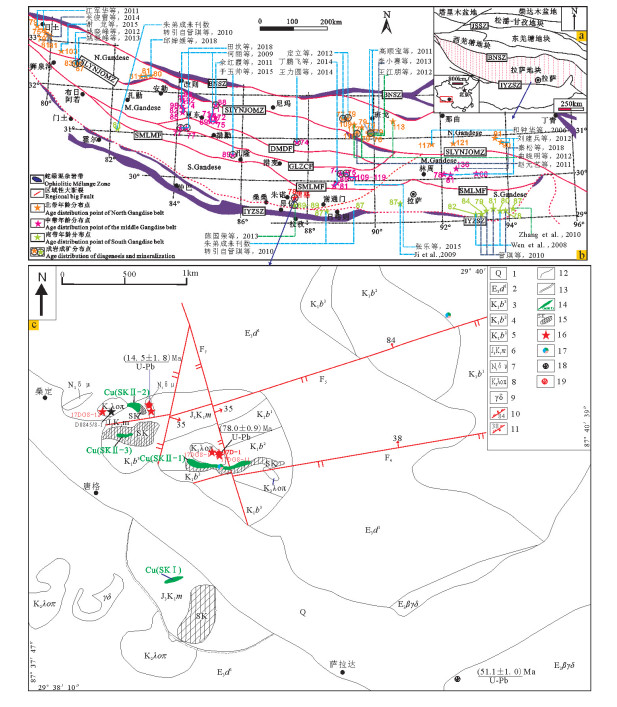
 下载:
下载:
